Frankel Block
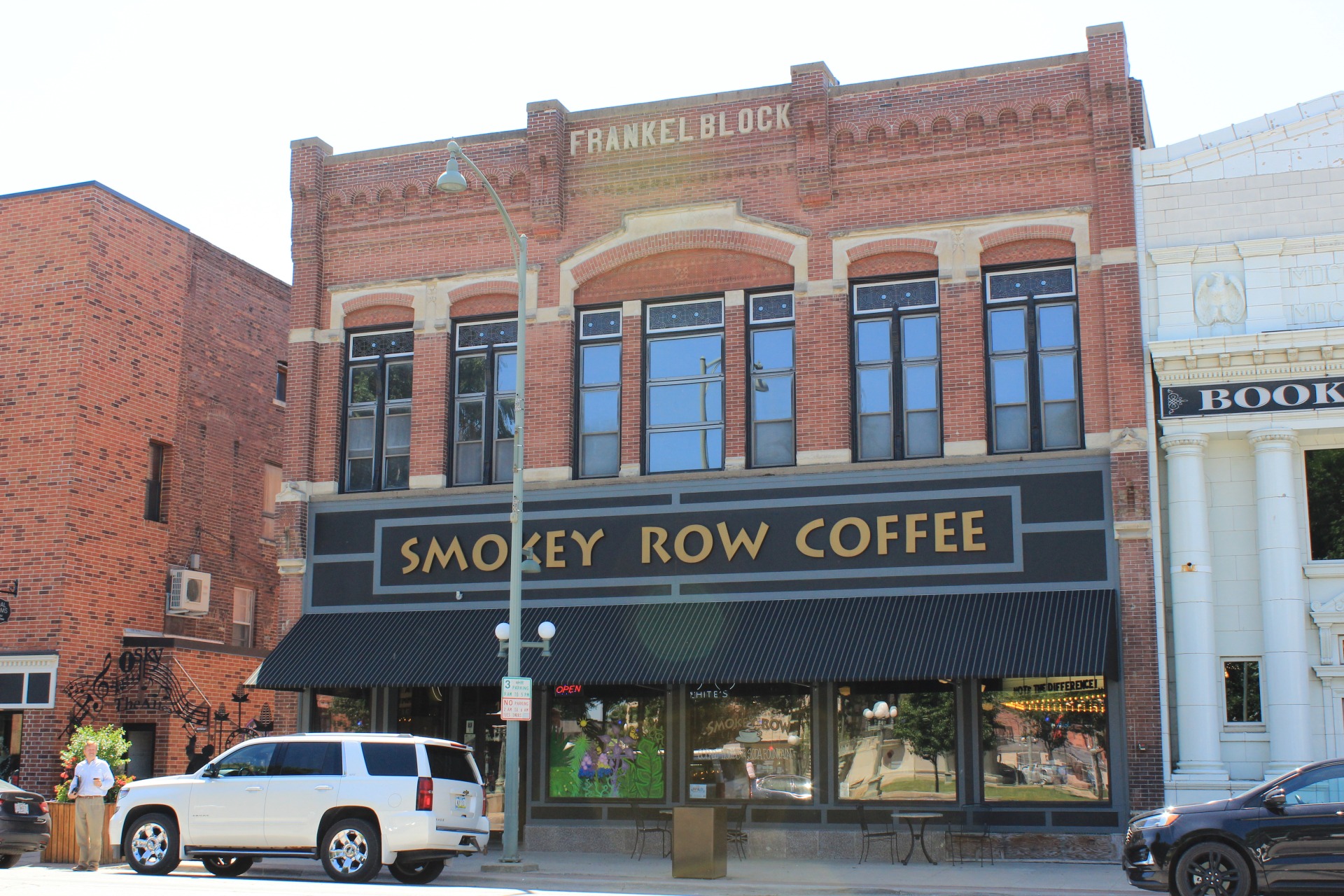
Key Information
- Year Built: 1889
- Location: 109 South Market Street
- Current Tenant: Smokey Row
- Architecture Style: Italianate
Architecture
The Frankel Building presently has the official address of 109 South Market, but over time consisted of three addresses—most recently it was 107, 109, and 111 South Market, but in earlier times it was 715, 716, and 717 South Market. Lots on the west side of the square were 60 feet in width and 120 feet in depth, with two of these lots—lots one and two—between High Avenue and the alley. In pioneer times, the typical storefront was 20 feet wide, so there could be three buildings in one lot, which resulted in the need for three addresses. For reasons unknown, this lot, officially recorded as “Lot Two in Block Twenty in the Original Plat of the City of Oskaloosa,” was over time divided in an unorthodox manner, with the Frankel Building consisting of the south 49 feet of lot two, just north of the alley. The remaining north 11 feet of lot two was combined with the south 10 feet of the adjacent lot one, producing a small middle building 21 feet in width. Finally, the “left-over” 50 feet of lot one, which extends to High Avenue, gives the footprint for the building on the corner.
The Frankel Building was built in 1889, and has the official architectural description of “Commercial Italianate building influenced by Victorian Romanesque style.” (For simplicity, the Historical Building Marker Committee opted to just use “Victorian” as the description on the marker.) Some interesting decorative features on the top of the building include:
- Turrets—these are the four small towers on the corners and in the middle
- Battlements—there are sixteen small brick projections, eight between each end pair of turrets
- Pediment—this is the triangular gable located at the top middle of the building
- Finial—this is the rounded emblem with a spire on top of the pediment—in this case, the spire also functioned as a flagpole
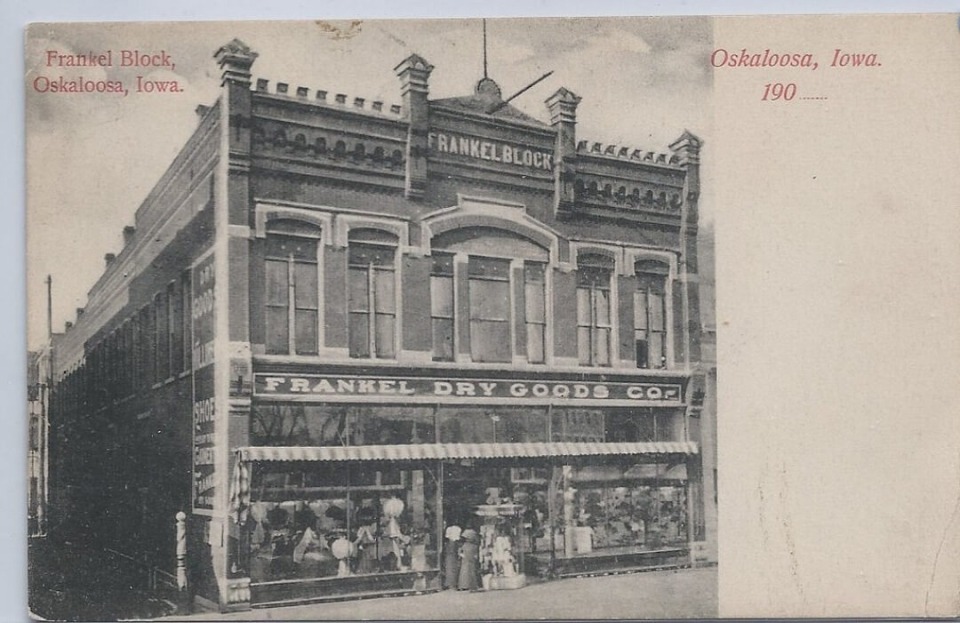
The above postcard is not the earliest picture of the Frankel Building, but one likely taken in the early 1900s. While the decorative features listed above are very clear in the image, they are now all gone. It is believed that they were removed when Kresge’s occupied the building in 1930. An October 15, 1929 news article, which announced the coming of the renowned Kresge Co., reported “A standard Kresge front will replace the old Frankel front.” This new style of retailing to the public did away with the phrase of “Dry Goods”, which is prominently depicted in the postcard. “Dry Goods” is an old term for clothing and textiles, which distinguished the Frankel from other merchandisers who might be selling hardware, boots and shoes, or groceries.
At the bottom left-hand corner there is also a structure, but it has nothing to do with the architecture of the building. It is a barber-pole, and is marking the entrance to a basement barbershop. It was very common to locate barbershops in the lower level of downtown buildings. There were lots of locations needed, as the 1900 census of Oskaloosa counted 41 citizens with the occupation of barber.
When a building or location becomes important enough to be depicted on a postcard, it shows that the owners in some sense have “arrived.” So this Frankel Building postcard, which proudly shows forth the Frankel Block and Frankel Dry Goods Company, naturally gives rise the question: who were the Frankels?
History
The Frankels
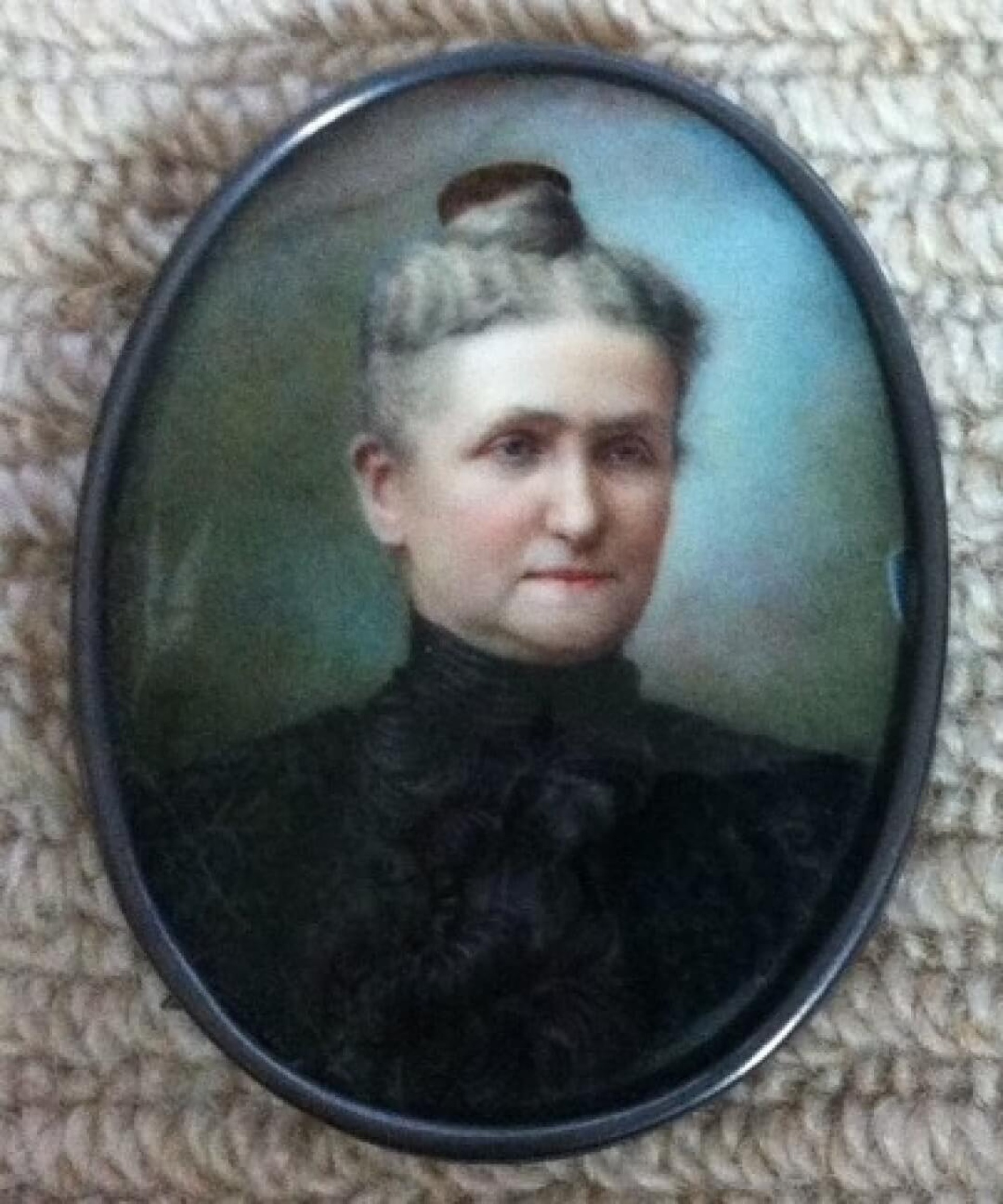
1840-1929
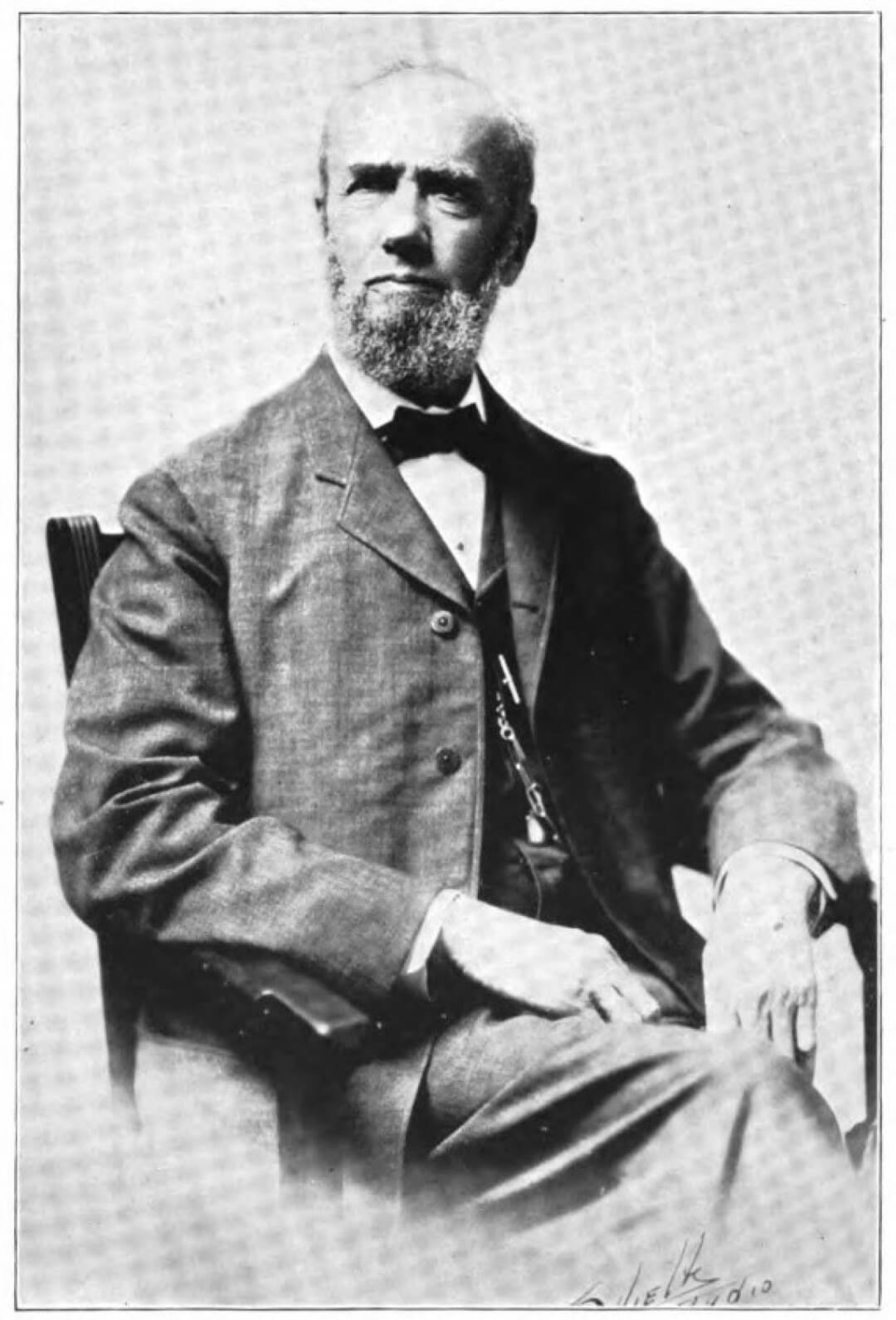
The namesakes of this building are Isaiah and Babette (Sheuerman) Frankel, who constructed it in 1889. Isaiah was 8 years older than Babette, and died in 1897 at age 65. Both Isaiah and Babette were Jewish, emigrating from Germany separately of each other in the 1850’s. It is suspected that the pictures below were taken near the end of Isaiah’s life—the 1896 Oskaloosa Times Souvenir book includes this picture of Isaiah with the caption of “Retired Banker.”
While the emphasis on the history of the building tends to fall on Isaiah—as he has the Frankel name—it is important not to omit Babette’s history. She was born in Binau, Baden-Wurttemberg, Germany in 1840, and lost her father when she was 17. Since her older siblings Abraham and Rosa had previously immigrated to the Mississippi River town of Muscatine, Iowa, this death thrust her older brother Leopold Sheuerman into becoming the family caretaker.
Leopold was just three years older than Babette and they remained close for the remainder of their lives. In fact, Babette and Isaiah, and Leopold and his wife Matilda Schwartz, were married in a double wedding. Leopold and Babette, along with their mother Sarah and sister Sophie, immigrated to Iowa in 1858, on the ship Othello. The two Sheuerman brothers, Abraham and Leopold, moved from Muscatine to Marengo, where they initially engaged in the dry goods business but later expanded into banking and woolen mills. The Sheuermans lived in Marengo in Iowa County for a number of years and built up their reputation and wealth, and, in what became a very typical pattern for Jewish immigrants, then moved from this rural area to the closest Jewish center of influence, which happened to be Des Moines. In 1882, they disassembled their factory and re-assembled it in Des Moines, renaming it Capital City Woolen Mills. In addition to this factory, they also built a factory in Des Moines for producing women’s clothing, and built branch factories in Newton and Marshalltown, creating an enterprise that employed over 400 people. Leopold eventually bought out his brother Abraham, and his Des Moines mansion below, still referred to as “The Sheuerman House”, testifies to his wealth and prominence.
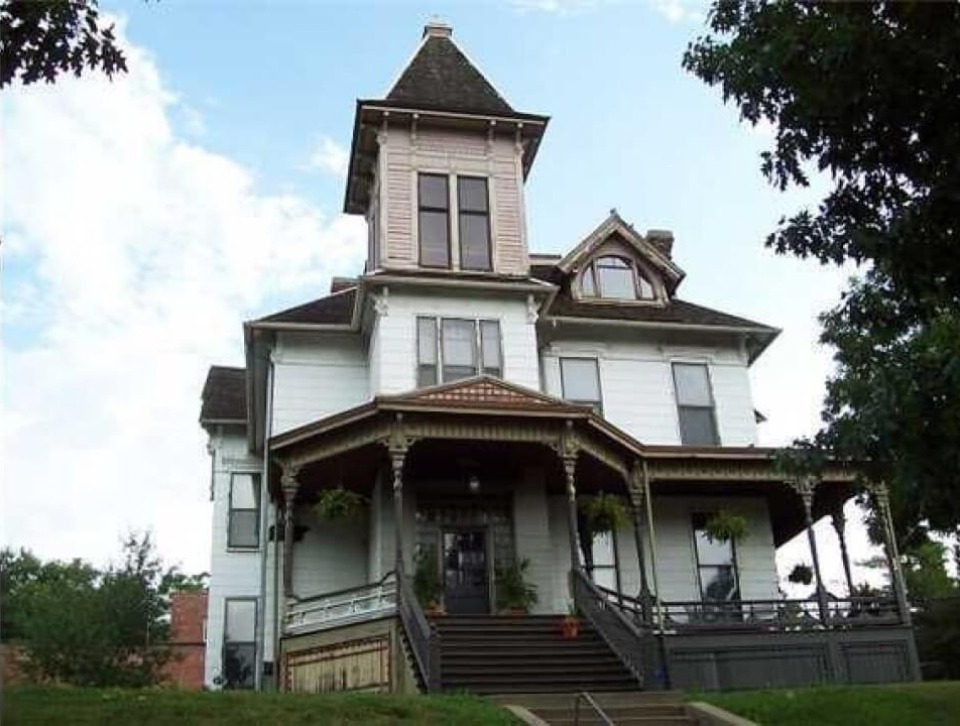
Shortly after Isaiah died in 1897, Babette moved to Des Moines. Her brothers’ families were already well established there, and the Frankel sons had been moving there as well. By the time of the 1895 State of Iowa census, Manessa and Nathan Frankel were living in Des Moines, and by the 1900 census most of the Frankels had moved out of Oskaloosa. The exception to this was Henrietta, who had married Herman Pfieffer and who were running the dry goods store. In 1916, there was a Des Moines celebration of those who came from the German area of Binau, and it was reported that “two of the original articles are present, Lee and Babette Sheuerman…… and entered into the nonsense with as much spirit as their youngest grandchildren.” As as indication of Babette’s relationship with Leopold, in 1917, they took a trip together to the Pacific Coast. While on the train, Leopold became ill, and he died in a Los Angeles hospital with Babette at his bedside.
Isaiah Frankel: 1832 - 1897
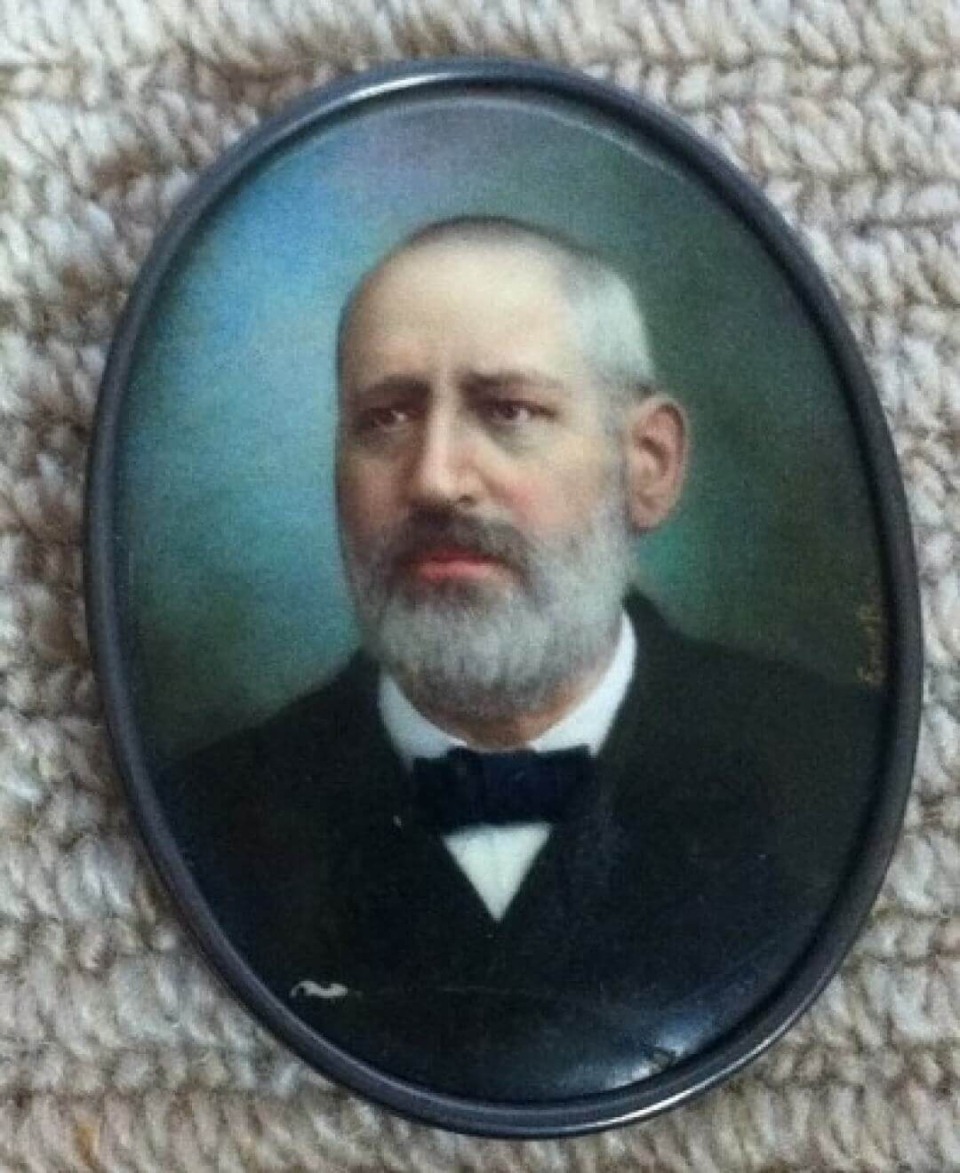
Compared to Babette, very little is known about Isaiah’s early years. He was born in Ichenhausen in Bavaria, Germany on 14 October 1832, and to date virtually nothing is known about his parents or siblings. There was a significant Jewish community in Ichenhausen, and a synagogue membership list of around 1843 lists an Anschel Frankel with a wife and one son. This might point to Isaiah’s family as Isaiah’s first son was named Anselm and often called Ansel, and it was very common to name a son after a grandfather. Also, during several census records there was a Sophie Frankel, born in 1830 (although this date, as well as her name of Sarah or Sophia, fluctated in different records) that lived with the Frankel family in Oskaloosa as early as 1880. She is reported as Isaiah’s older sister in this census, and followed the Frankel family to Des Moines where she died and was buried in the Frankel family plot. While in Germany, it is reported that Isaiah worked as an apprentice for a cigar-maker and also was a clerk in a mercantile house.
At the age of 21, Isaiah immigrated by himself on the Hope Goodwin, which left Le Havre, France to arrive in New York on September 13, 1853. His first stop was in New Washington, Indiana—the connection to that town is a mystery. While there, he operated a dry goods and clothing store, and stayed there for a total of three years. He then went to Macon, Missouri, where opened a dry goods store. This is where the first known public record of Isaiah appears, within the 1860 census.
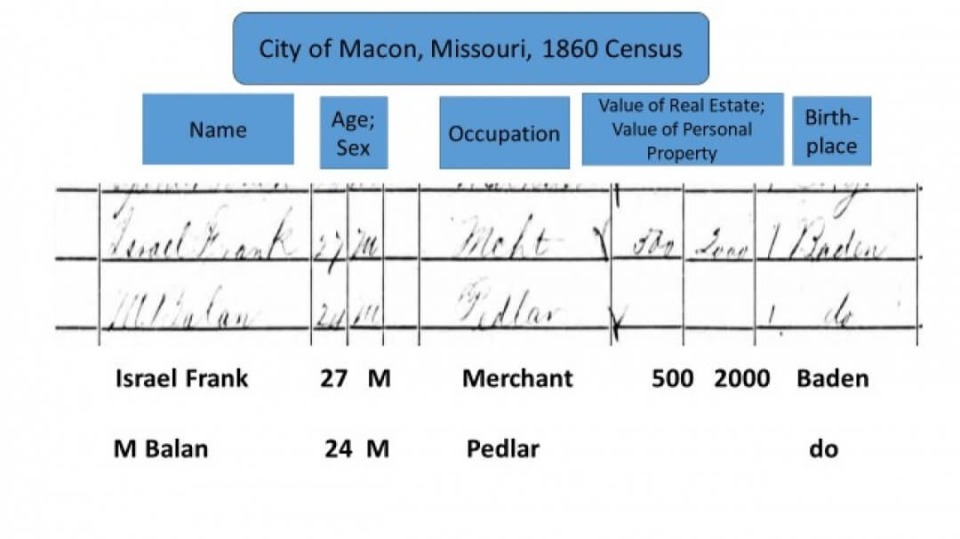
Depending on the personality of the census taker, accuracy was often “optional” in those days, and this particular entry is no exception. Note that Isaiah Frankel is shown as “Israel Frank,” and that the German home state of Bavaria is shown as “Baden.” But there are a couple of items that are of interest. First of all, right below Isaiah is “M Balan”, who is believed to be Emanuel Bach, with “Manni” often a nickname for Emanuel. It is known that Isaiah and Emanuel came up from Missouri to Oskaloosa together, and they were partners for almost 30 years, first in the dry goods business and later on in banking. The adjacent names would indicate that they were living together, which in this case was in a boarding house or hotel, as there were a number of people with various occupations recorded as being on one property. The fact that Isaiah owned real estate and a stock of goods points to the early success for this immigrant who had been in this country only seven years—the total reported value of $2,500 would be $76,000 in today’s dollars. Given the occupation descriptions, it appears that Isaiah took charge of the store while Emmanuel likely went out in the huckster wagon.
There are several accounts stating Isaiah and Emanuel came from Missouri to Oskaloosa in May of 1861. While the reason for choosing this destination is unclear, the reason for leaving Missouri is not. In April of 1861, the shots were fired in Fort Sumter, South Carolina, that started the Civil War. That same month, a Missouri ex-Congressman from nearby Palmyra visited Macon, and gave such a rousing speech in favor of the South that the Confederate flag was raised. The very next month, the secession Missouri Senator James S. Green was giving a speech in nearby Bloomington, and during the speech word was received that the Union army took over Camp Jackson in St. Louis. This incited the crowd so much that 300 men gathered in Macon with muskets and shotguns, and plans were made to have drills and muster more volunteers. This must have been very unsettling for Isaiah and Emanuel, so they opted to move north. Their journey to Oskaloosa gave them the distinction of being the first Jews to settle in Oskaloosa.
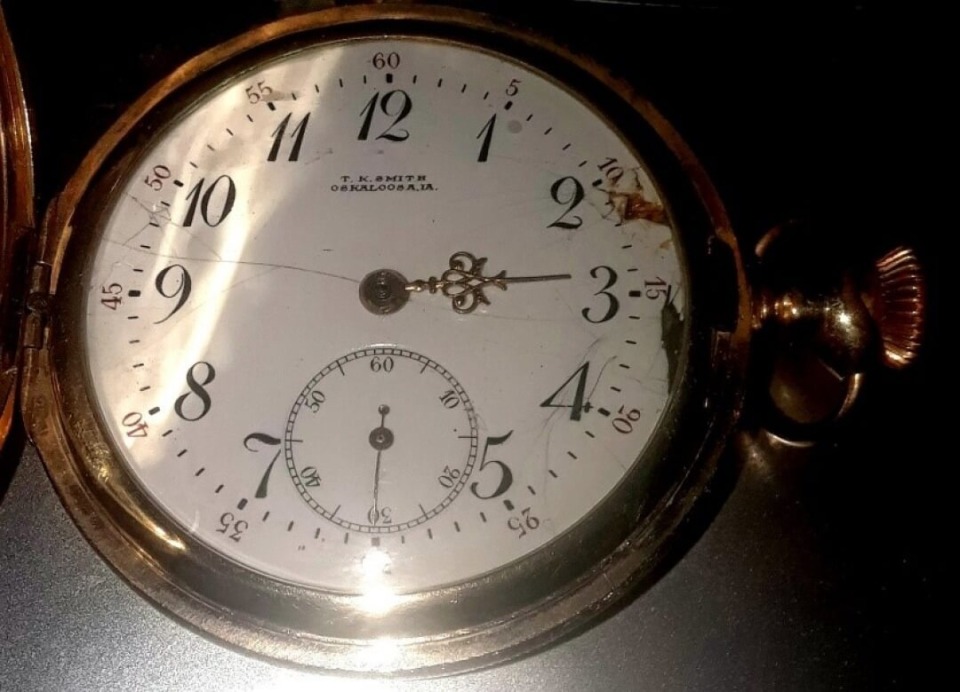
Early Years in Oskaloosa
Isaiah and Emanuel, both still bachelors, established their clothing store on the east side of the square where the courthouse now stands. Coming with them from Macon was Theodore K. (known as TK) Smith and family. As TK’s birthplace was New York, it is likely his northern roots were making him increasingly uncomfortable with living in the seccesionist environment in Missouri. In Iowa, he had one side of the store for his jewelry business, and Isaiah and Emanuel had the other side. TK remained in Oskaloosa the rest of his life in the jewelry business, and also served on the Oskaloosa City Council. He gained enough renown that he put his own imprint on several pieces of jewelry, such as this watch at right.
The Frankel clothing business was successful; within a year, the enterprise, known as I Frankel & Co., had outgrown its quarters and moved to another location, also believed to be on the east side of the square. This location also soon proved to be too small, so the firm moved into a property on the north side of the square. This was situated just a couple buildings east of the present Centennial Building. It was located inbetween stores owned by John Abraham, who had a grocery store on one side and a “queensware” store on the other. Queensware is an old term for china and pottery. In the picture below, taken during the Civil War, one can clearly see the words “Dry Goods” and “I Frankel & Co.”
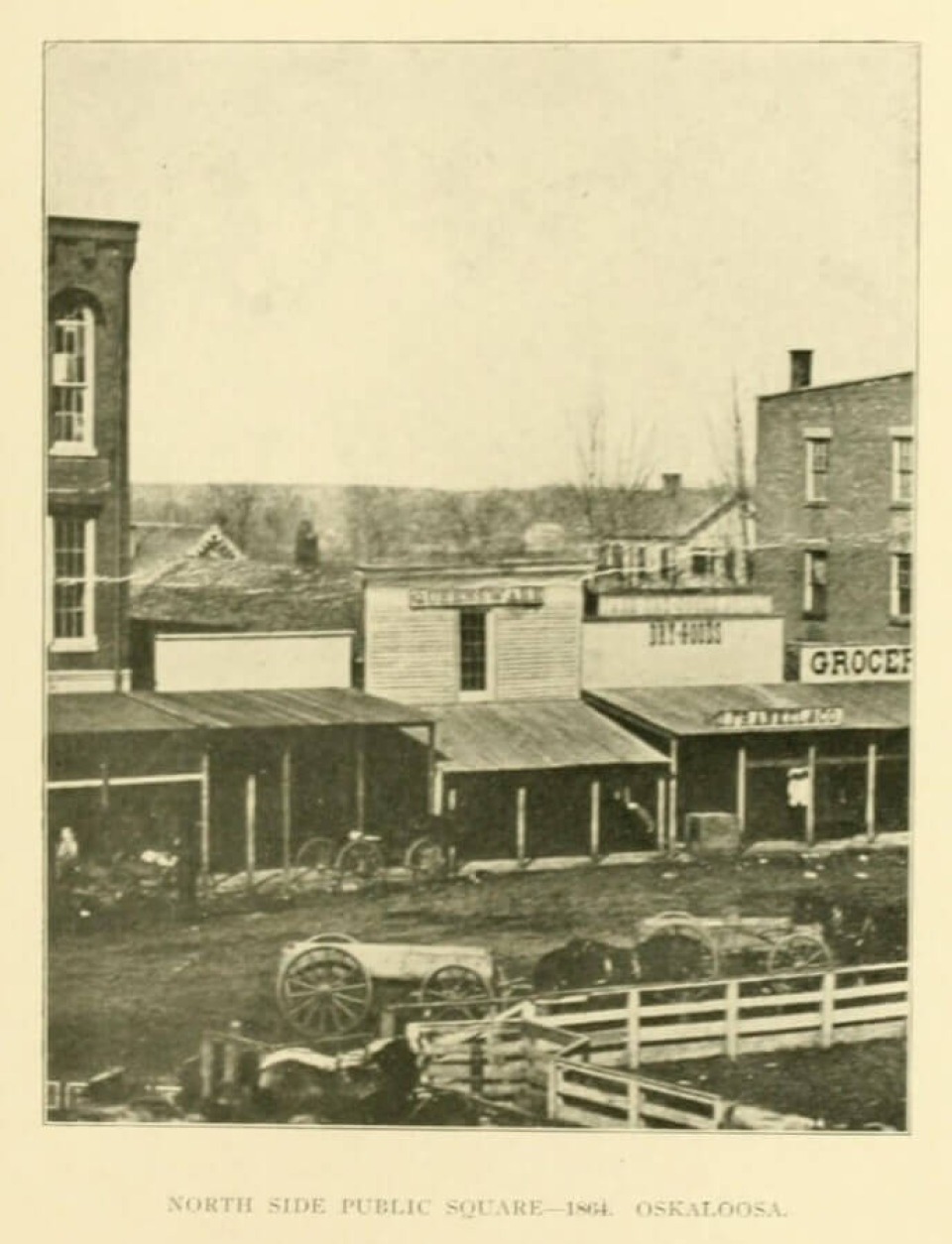
The move to the north side of the square boosted Isaiah and Emmanuel’s business; it was there that they also began the side business of buying wool. This proved to be a good move, as Mahaska County had a significant sheep industry. An 1869 Herald article stated the business had purchased over 20,000 pounds of wool; an 1887 article notes that 120,000 pounds had been purchased over a two month period, with 88,000 pounds produced in Mahaska County. The 1869 article states that the wool was sold to firms in Chicago and Warsaw, Illnois; by 1887, the westward movement of industry was made evident, as all of the wool purchased was going to the woolen mills in the Amanas in Iowa.
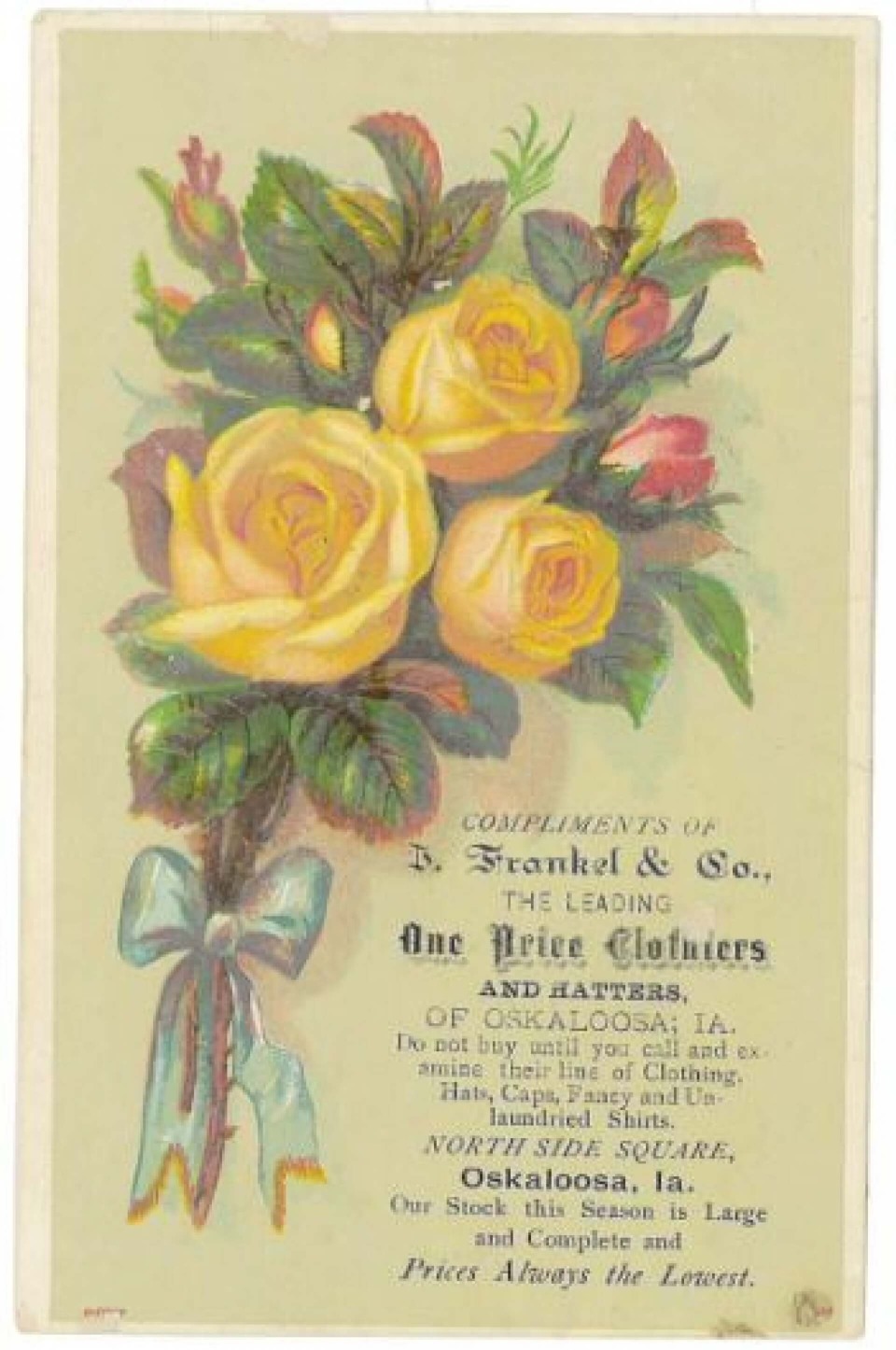
An example of the firm’s growing prosperity was its distribution of business trade cards (example at right), which was a method of showcasing and advertising its success. These cards were typically beautifully colored and were handed out to customers, who collected and traded them. An enduring advertising slogan with the store was “One Price Clothiers.” It is believed that in that era it was not uncommon to “haggle” over the price of clothing items—Isaiah and Emanuel touted the fact that their prices were so slow that customers could accept the “one price” that was offered.
It is noted that that this trade card also specifies the word “hatters.” This may be because during this time period, one of the most important events happened in Isaiah’s life—his marriage to Babette Sheuerman. When Babette immigrated to Iowa in 1858, she began working with her sister Rosa in a millinery store in Muscatine. In that era, when hats were popular for both men and women—and often elaborate hats for the latter—a “milliner” was someone who made hats and a millinery was where hats where sold. While Babette’s brothers Abraham and Leopold moved to Marengo, it appears that Babette stayed in eastern Iowa. Her memoirs state that she met Isaiah in Chicago, but it is not clear whether or not she had ever moved there. It is plausible that both Isaiah and Babette had been in Chicago on a clothing or materials buying trip for their respective occupations. In any event, they fell in love, and all Iowa Jewish literature touts their marriage on January 20, 1864, as being the first orthodox Jewish wedding in the state. It is noted that this recognition may have occurred solely because this particular document survived, as this ceremony in Davenport was a double wedding with Babette’s brother Leopold getting married at the same time. While Jews had been married in Iowa prior to this date, they had likely done it via a Justice of the Peace or other government official. At left is a replica of the marriage document written in Hebrew, known as a K’THUBAH. The rabbi that performed the ceremony was Rabbi Ignatz Kunreuther, a German-born Jew who is recognized as the first rabbi of Chicago. The fact that Isaiah and Babette could afford to have this rabbi travel from Chicago to Davenport to officiate their marriage testifies that they were well on their way to prosperity already in 1864.
West and North of the Square, from 1869 to 1889
As the clothing business continued to flourish, Isaiah and his new bride Babette, along with their bachelor partner Emanuel Bach, started looking for larger quarters. They found it on the west side of the square, and for the first time they purchased a property instead of renting it. This building was 29 feet wide and 120 feet deep, and represents part of the footprint of the Frankel Building today—the portion directly north of the alley. This building was one of the first, if not the first, brick building built on the square. There are conflicting accounts as to who constructed the building. One source says it was William Mieir, but this is doubtful as he only owned the property from 1848 to 1849. It was more likely built by the next owners, the brothers George W. and John W. Jones. They were early Mahaska County merchants in the now-defunct town of Auburn who moved to Oskaloosa when their efforts to make Auburn the Mahaska county seat failed. They were in Oskaloosa but a few years and moved on in 1855, with George becoming an Iowa legislator from Polk County and John becoming the State of Iowa Treasurer from Hardin County.
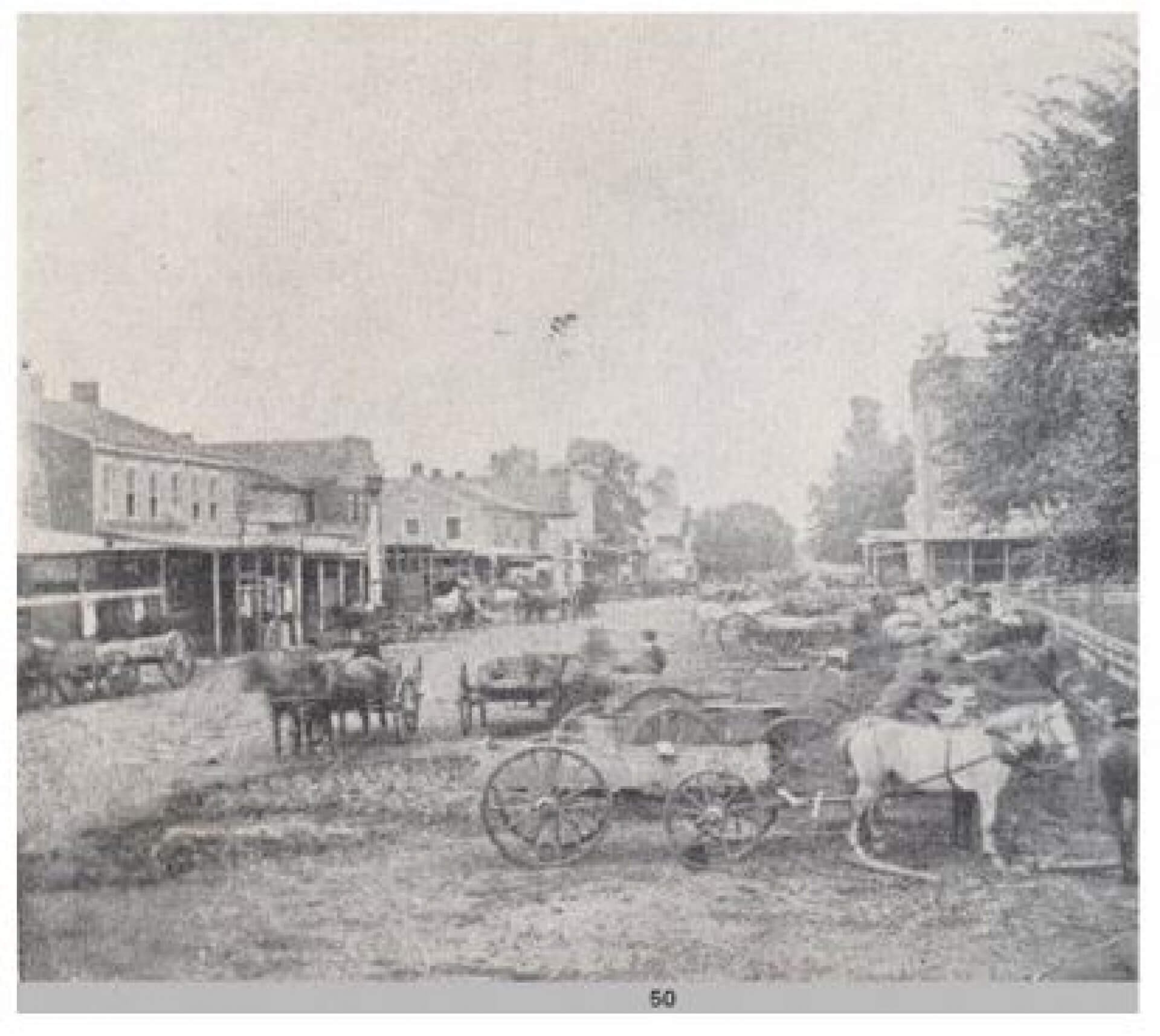
Right: This is an 1864 picture of Market Street on the west side of the street, facing north from the southwest corner of the square. The building purchased by the Frankels and Emanuel Bach in 1869 is the one the far left-hand side, with seven windows on the second story. This upper story was used for living quarters. At that time, the Mahaska County courthouse was further north on Market Street, at the northwest corner of High Avenue and Market. You can see two of its second story windows facing south.
This move to the west side of the square again proved to be successful—many clothing stores came and went during this time period, but the Frankel store remained and prospered. In fact, the business was doing so well that Emanuel and Isaiah branched into the banking world by establishing a private bank known as Frankel, Bach, & Company. Both the clothing store and the bank operated out of this location.
In 1876, after the business once again outgrew its space, Isaiah and Emanuel purchased a property on the north side of the square just a couple buildings away from where they operated from 1863 to 1869. They demolished the existing structure and built a brand new building, naming it the Centennial Building in recognition of the United States’ 100 year anniversary. One side of the building housed the clothing store, and the other side had the bank. As the Centennial Building also has been honored with a Historical Building Marker and is featured as such, the details of that building will not be repeated here, with the reader encouraged to view that link for more information.
Isaiah and Emanuel operated at this Centenial Building location until 1888, when Isaiah purchased out Emanuel’s interest in all the Oskaloosa endeavors. Emanuel had gotten married in 1879 to Carrie Kohn, who was a Chicago native and who was 10 years younger than Emanuel. Their wedding was a lavish affair in Chicago, and it would not be unreasonable to suspect that life in rural Iowa was not easy for her. So, in 1888, after over 35 years of being in business together, Isaiah and Emanuel went their separate ways, with Emanuel moving his family to Chicago and becoming a wholesale dealer of wool and furs. The name of the clothing store was changed from I. Frankel & Co. to I. Frankel & Sons, as Isaiah’s sons Ansel and Manassah became partners in the business. The next year would be an important year for the Frankels, as that is when its landmark building on the west side of the square would be constructed.
The Frankel Building
While Isaiah already owned the real estate where old existing brick building was located, his plans were far more grand than that. So he bought the building directly to the south, which at that time was a also a two-story brick building that housed a boot and shoe store owned by Norman and John Dodge. The building that Frankel already owned was a two-story building in the front with just one story behind it.
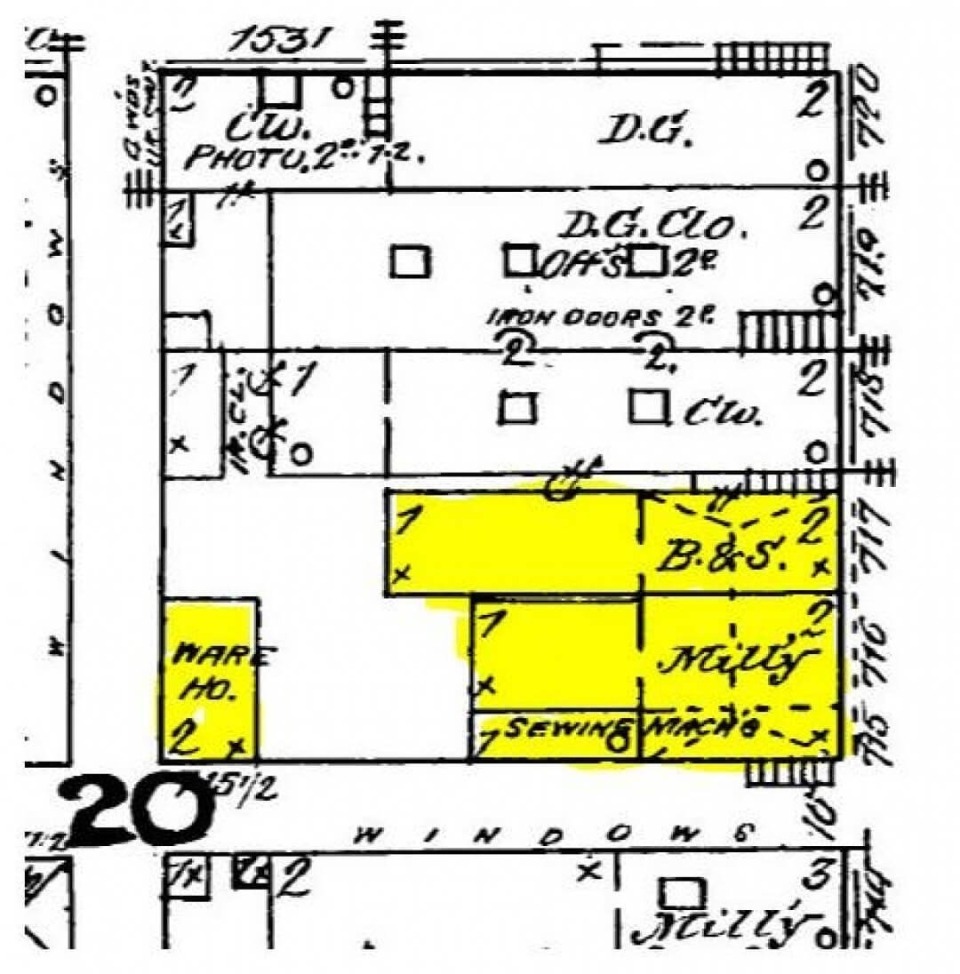
Once Isaiah had control of the properties, he went to work on the construction. He used the Des Moines architectural firm of Foster & Liebbe, and the local general contractor was Henry Wetherell. In later years, the Wetherell name would be widely connected to Oskaloosa, not by Henry but via his son Frank, who became a well-known regional architect in Des Moines. Frank left his mark on many buildings he designed in Oskaloosa, including the fire station, City Hall, public library, and bandstand. It was reported that Isaiah gave this order to Henry Wetherell on February 1, 1889: “I want the building completed by the first of August, Mr. Wetherell, but there most be nothing slighted in any way. Everything must be of the best and most substantial, for I want the building to be a credit to all concerned.”
Not everyone was happy with this project. A writer who only identified himself as “the Lounger,” submitted this to the Oskaloosa Herald (italics added for emphasis:
“The Lounger notes the removal of the Frankel brick on the west side of the Park. That building was the first brick business block erected in the city. It was put up in 1850, and the adjoining on the south was erected the year following, and at the time was the largest block west of Keokuk. The building now being removed to give place to something modern was erected after the style of the old business rooms in a Pennsylvania village, with living apartments on the second floor. Its removal shows the growth of modern wants and ideas. That which was good and comfortable a few years ago is cast aside, and the most elaborate that man can plan is ordered up, whatever the cost.” Whether this writer was just being nostalgic or envious of the success of an immigrant with an uncommon religion is anybody’s guess. But in any event, this did not deter Isaiah, and he went forward with this project with gusto."
A March 1889 Herald article described the project:
"The front end of the basement will be finished off and used as a barber shop—20 by 47 feet, and made as convenient as possible. The first floor will be one great store room: 48 by 120 feet, with a 16-foot tall ceiling. The windows in front will be very large—84 x 170 increches each, and will be backed by a display recess of 14 feet. The room will be finished off in the very best style, solid oak, and will be second to none in general effect in the State. The exterior front will be handsomely ornamented, with stained glass and all the other accessories of modern architecture. Its effect will be beautiful and imposing, and will be the best in the city. The second floor will be made into nine complete double office suites. There will be an entrance from the front by an easy stairway, and an outside stairway on the alley. Each suite of rooms will have a good window and skylight, so that there will be an abundance of light. Several of the suites have already been taken. All the work will be of the most substanial character in every department. Henry Wetherell is the superintendent of construction, and that means a pushing man behind the work. In this block Mr. Frankel will expend many thousand dollars, and he erects a monument that will be a lasting credit to his enterprise as a citizen, and to his faith in the town and section that has afforded a long and prosperous career. Unlike others, Mr. Frankel stays by the land and section that has proven good enough for him all the years that he has been a resident here. The Board of Trade will hold a banquet in the first floor room just before the shelving goes in—a sort of celebration of a splendid event afforded by one of the ablest and most enterprising of our citizens."
Of note was the fact that Henry F. (Frank) and Benton Harbour were the brick masons on this project, while their father—Richard R. Harbour—was the brick mason on the building that was torn down. The limestone for the foundation came from the quarry near the town of Givin in Mahaska County. A “nest of boilers” was built in the basement by Dan Haworth, and they provided steam heat throughout the entire building. As the big day of opening the buisness approached, moving the inventory from the old store on the north side of the square to this new one appeared to be a daunting task. So, to ease the burden as well as to prime the market for his new store, Isaiah ran this advertisement:
Isaiah’s admonition to general contractor Henry Wetherell about the August 1 completion date proved remarkably accurate for such a big project. As such, the public was informed about the grand opening with the following ad:
The grand opening was a big success. The Knights of Pythias band began playing in the park early in the evening, and by 7:30 such a large crowd had gathered that the street was impassable to traffic. The Herald reported:
"It was an outpouring of the people that should have been immensely satisfactory to the gentleman whose wealth, taste, and enterprise had made possible such a magnificent material success. It seemed as if all of the old friends and business acquaintances of Mr. Frankel had come out in a body to do honor to him as a citizen of enterprise, push, and one having large faith in the future of the town and county—a faith large enough to bring about the erection of a clothng house second to nothing in the West in the completeion of its appointments, solidity, and substantiability of its construction."
The crowd was immense—over 4,000 souvenir ships were handed out, and the paper reports that over double that amount could have been given away based on the crowd that went through the doors. When you think that Oskaloosa had a population of 6,558 in the 1880 census, this testifies to the huge turnout that took place, with people coming from surrounding areas to take part.
Following the grand opening, all of Isaiah’s competitors were purchasing large amounts of newspaper advertising, obviously nervous about the grand new venture. Isaiah remained conspicuously silent. In retrospect, this was actually a good business move, as it is supected that the public was already flocking to his new store without the need for advertising. Finally, on November 7, he placed a nearly full-page advertisement in the Herald, a portion of which is replicated below:
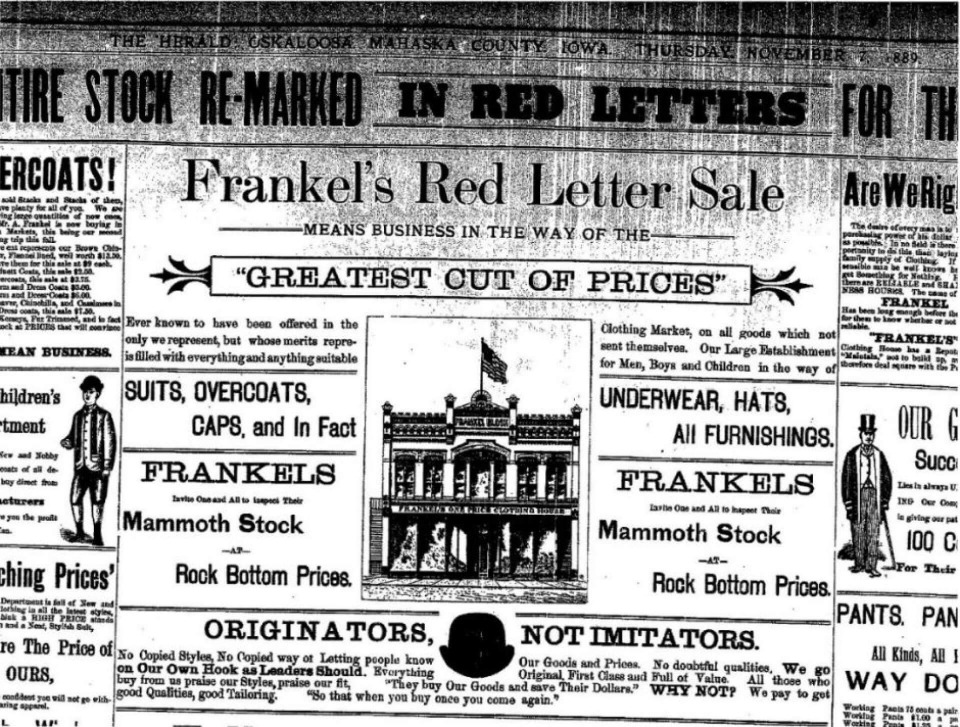
The graphic in the middle of the advertisement depicts the first image of the building. What follows below is a side-by-side picture of this graphic and what is believed to be the first photograph of the building. The men in the front of the picture are not identified, but it seems likely that they would be some of Isaiah’s sons and some of the business owners who had rented suites on the second story. Soon after the building opened, it was reported that an abstract and title company, a life insurance business, an attorney, an eye doctor, a dentist, two physicians, and the coroner had all located their offices in the second-story office suites. The graphic clearly depicts the outside stairwell on the lefthand side, and the inside stairwell on the right-hand side. An interesting English-grammar twist regarding the apostrophe is noted in the two images—the graphic includes the name “Frankel’s”, while the actual photograph proves it to be “Frankels’ “. This shows that the enterprise had indeed passed on from Isaiah as a sole proprietor, to a family business which included his sons Anselm, Mannasah, Henry, and Nathan.
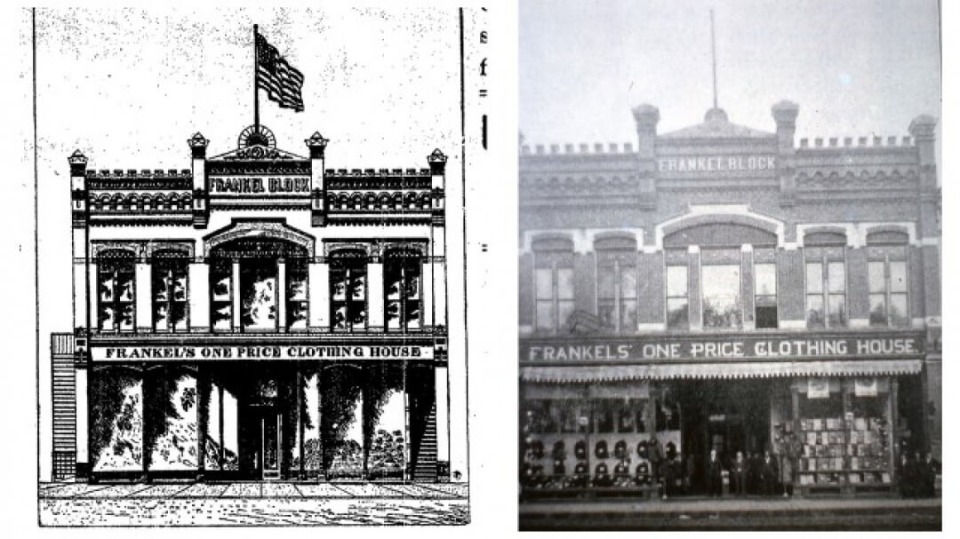
The Post-Isaiah Frankel Years, 1897 to 1929
By 1900, all but one of the Frankel children and Babette had moved away from Oskaloosa. The exception to this was daughter Henrietta, who had married Herman Pfieffer. Herman and Henrietta carried on the clothing business in Oskaloosa, likely with assistance from the Frankel brothers in Des Moines and sometimes with the help of a local partner. For a time the local partner was Harry Strasburger, and as the picture below shows, the name was even on the storefront:
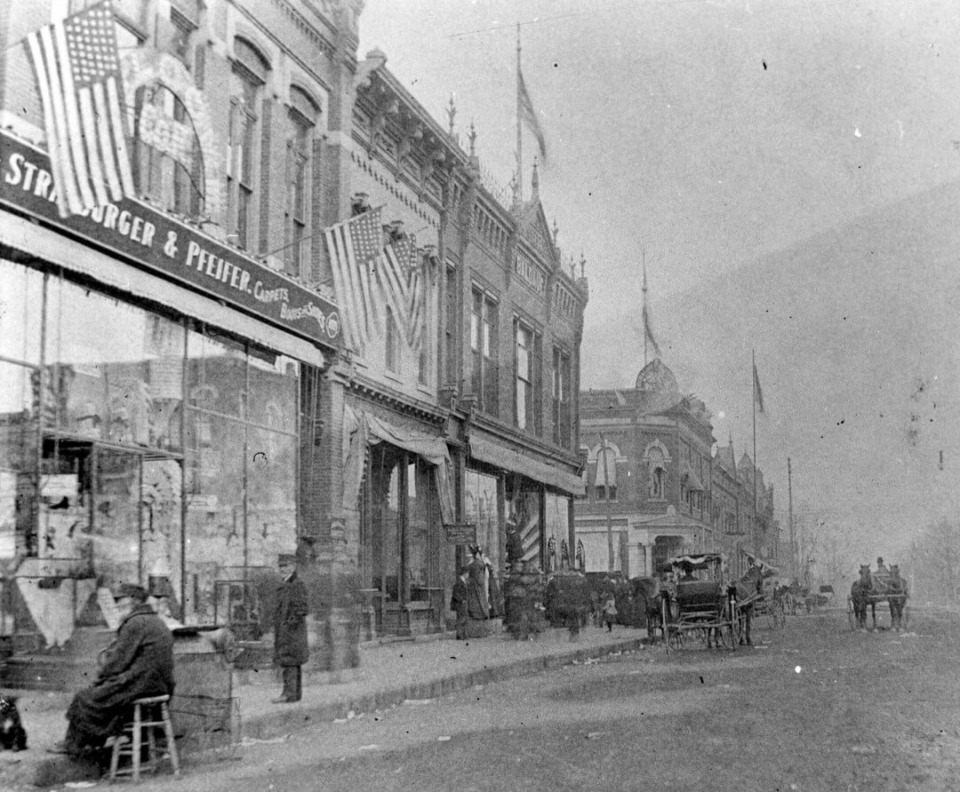
Note that the flag in the upper left corner in the above photograph has 45 stars, and since Utah was the 45th state admitted to the Union in 1896, and Oklahoma became the 46th state in 1907, this picture would have been taken between those two dates. It was likely around the turn of the century, as Harry Strasburger left the business in 1902. He was followed by E. H. Belmont, and the business was then known as the Pfeifer-Belmont Co. However, Herman Pfeifer died in 1910, and his widow Henrietta left Oskaloosa and moved in with her mother in Des Moines.
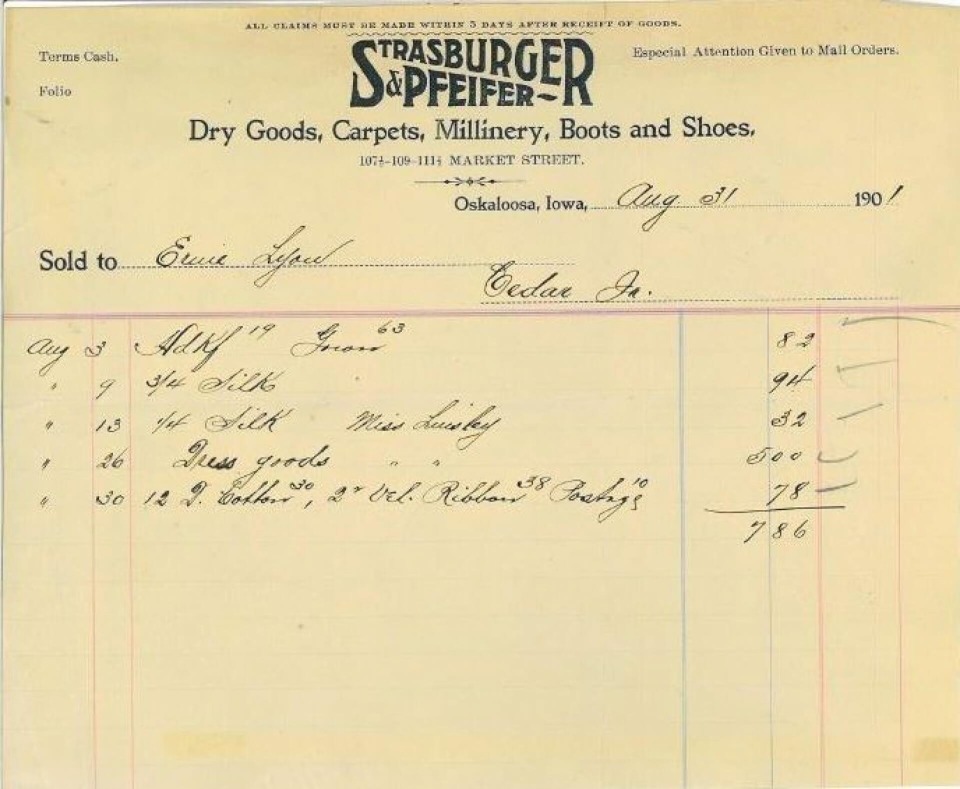
Right: 1901 Invoice from the Strasburger & Pfeifer Store. The buyer was Ernie Lyon, who was a dry goods merchant in the Mahaska County town of Cedar, indicating that Strasburger & Pfeifer also had a wholesale business in addition to the retail store. Note that all the purchases were made throughout the month on credit, with this invoice being prepared at the end of the month for payment.
From that point on, all Frankel family involvement was based out of Des Moines, and their interest in the Oskaloosa market was phased out as their business expanded in Iowa’s capital city. The business two buildings to the north of the Frankel Building—Baldauf-Rosenblatt—was also owned by members of Oskaloosa’s German/Jewish community. That building had a 3rd floor added in 1910, so the preceding picture was taken before that date. Transportation modes now included a unicycle, as noted by the gentleman in the middle of the street. Despite the Frankel family’s business interests in Des Moines, continued improvements were made at the Oskaloosa location. The inside stairway on the northeast corner that went to the second story was removed, and in its place a freight elevator and a passenger elevator were installed. All the offices on the second floor were removed, making it one big room to increase the floor space for items for sale.
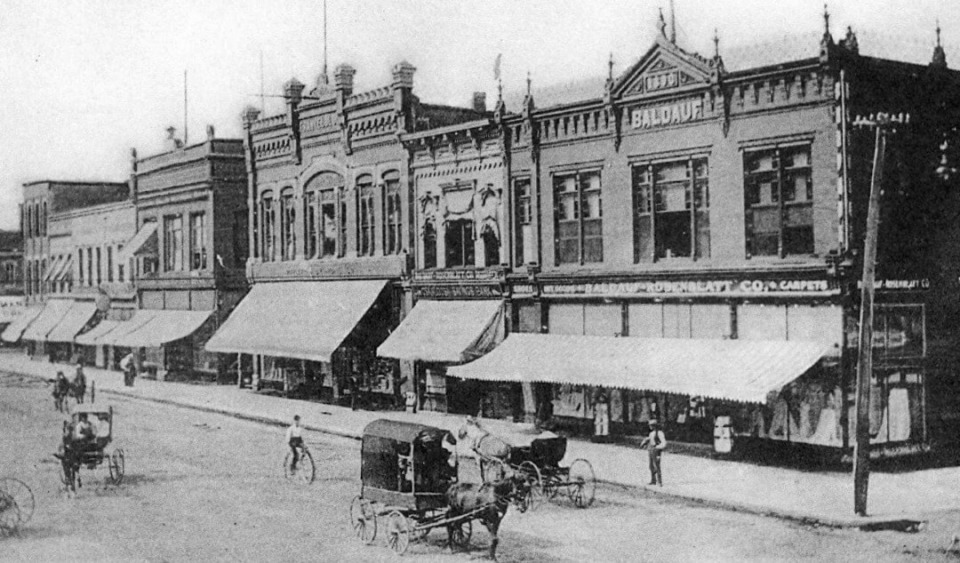
Regarding this expansion, the Oskaloosa Herald proclaimed in 1908:
“Contrary to general predictions and the statements of those who are pleased to be regarded as ‘the conservative class,’ the city seems to be employing an early building boom. Many predicted that there would be little or no building on account of the unsettled conditions of the presidential election year generally. The oppositie of the forecasts is proving to be the case.” In 1909, as the Frankels may have been in need of some capital for their Des Moines expansion, they sold part of the business to four local investors, one of them being Dr. Moses Childress. They did not sell the building, only a part of the retail business which had been renamed the The Frankel Dry Goods Co."
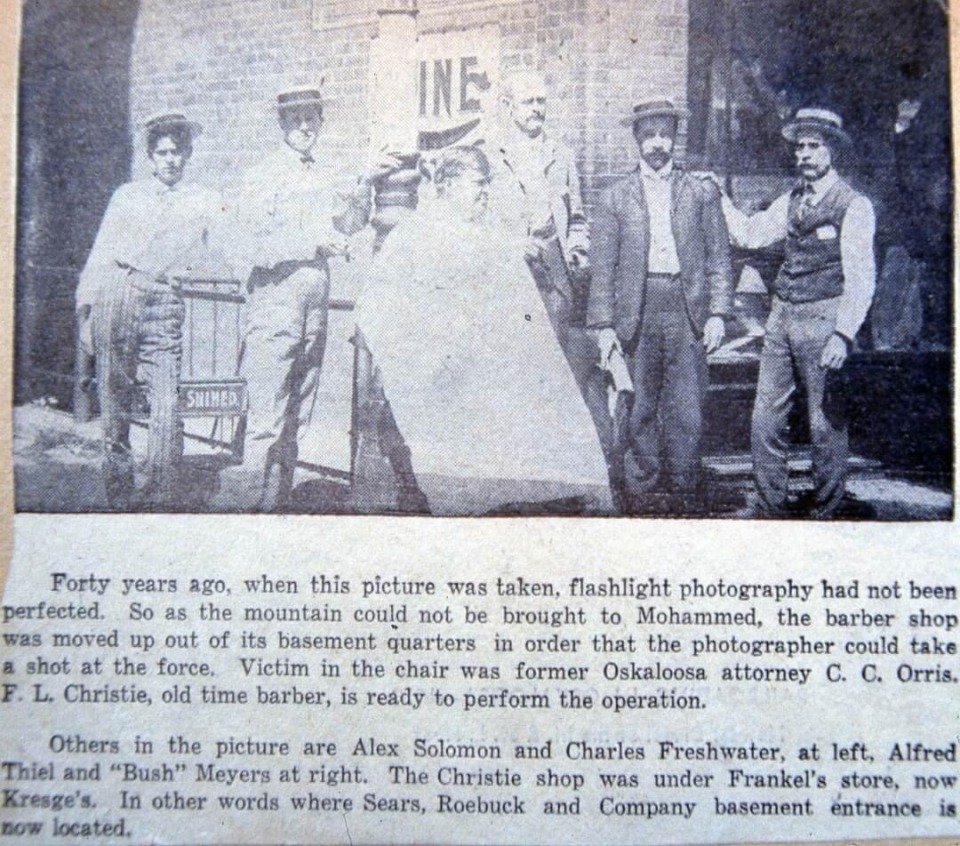
Above: Barbershop group picture, from the basement of the Frankel Building, taken on the southeast corner in 1910. Note the barbershop pole, which is the same pole in the very first picture of this history. The person on the far left was Alex Solomon, who was a barber there and who was around 22 years old at the time. His parents had been born in Wales, and were likely attracted to Mahaska County’s coal mining industry. He married Cora Wichhart who had been born in the Netherlands, and later moved to Pella. This testifies to the rich diversity of Oskaloosa at the time—the son of Welsh Methodist immigrants, working in the basement of building constructed by a German Jew, who would later marry a Dutch Reformed immigrant from the Netherlands. However, while this picture presents a happy, idyllic scene in small-town Iowa, we should also be reminded of the high mortality rates of the time, especially among infants. A person born in 1890, close to the time of Alex’s birth in 1888, would have an estimated life-span of 43 years if a male and 45 years if a female. Alex, in fact, did not even reach this statistic—while in Pella he contracted the dreaded disease of typhoid fever, and died at age 32, leaving a widow and two children. Because of that and similar events, Second Reformed Church of Pella, where Alex attended, cancelled its church picnic that year due to the contagion of the disease.
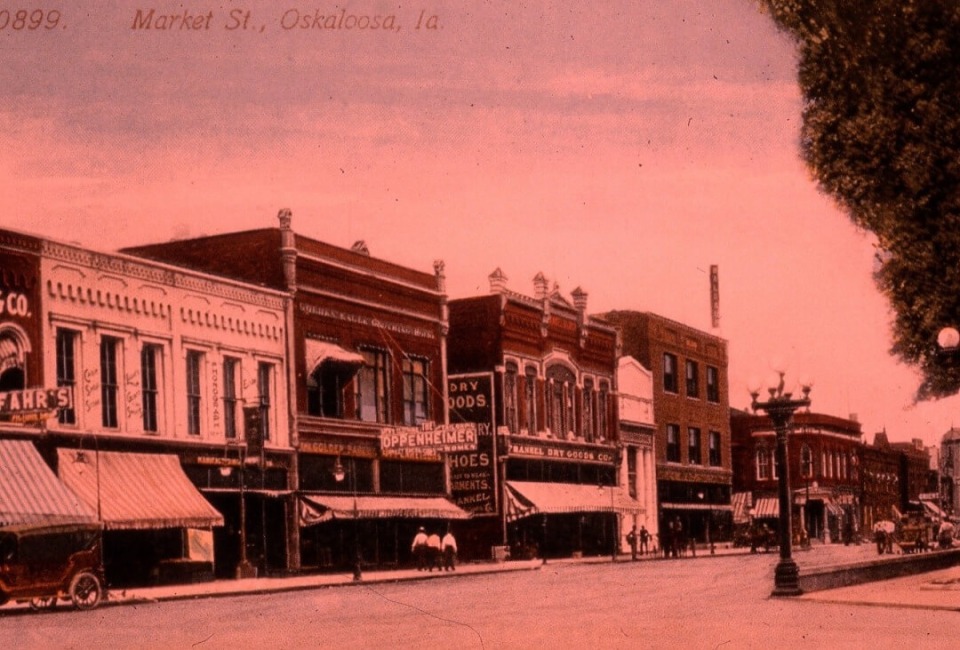
Above: A colored picture-postcard is from after 1910—likely the late teens—as one can see that the Baldauf building on the corner had the third story added. The words Frankel Dry Goods Co. can clearly be seen on the building, and transportation has changed: in addition to horse-drawn carriages, there is also an automobile in the picture. The Oppenheimer Store, just across the alley to the south of the Frankel building, represents another German-Jewish business, and next to it is the Golden Eagle. In 1914, C. C. Alsop came to town from Missouri as the manager of the Frankel Store. This last name would become identified with Oskaloosa retailing, as in later years C. C., and then his son Carroll, had the store known as “Alsop’s.”
In 1921, a major consolidation of Oskaloosa’s leading retailers took place, with Oppenheimers, The Golden Eagle, Frankel Dry Goods, and Baldauf’s all uniting under the name Oppenheimer-Alsop. The goods that were in the building south of the alley were brought to the Frankel and Baldauf buildings. The basements between the buildings had already been connected; the next step was to cut openings on the second story of the bank building between the Frankel Building and the Baldauf Building so that shoppers could walk from one building to the other. Despite the removal of the names of “Frankel” and “Baldauf” from the storefronts, these two families continued to maintain part ownership of the business even though it was being diluted by other investors. By this time, the Frankel family had already disposed of owning the real estate. In 1920, the year before the consolidation, Dr. Moses Childress—one of the investors who bought into the retail business in 1909—purchased full ownership the building.
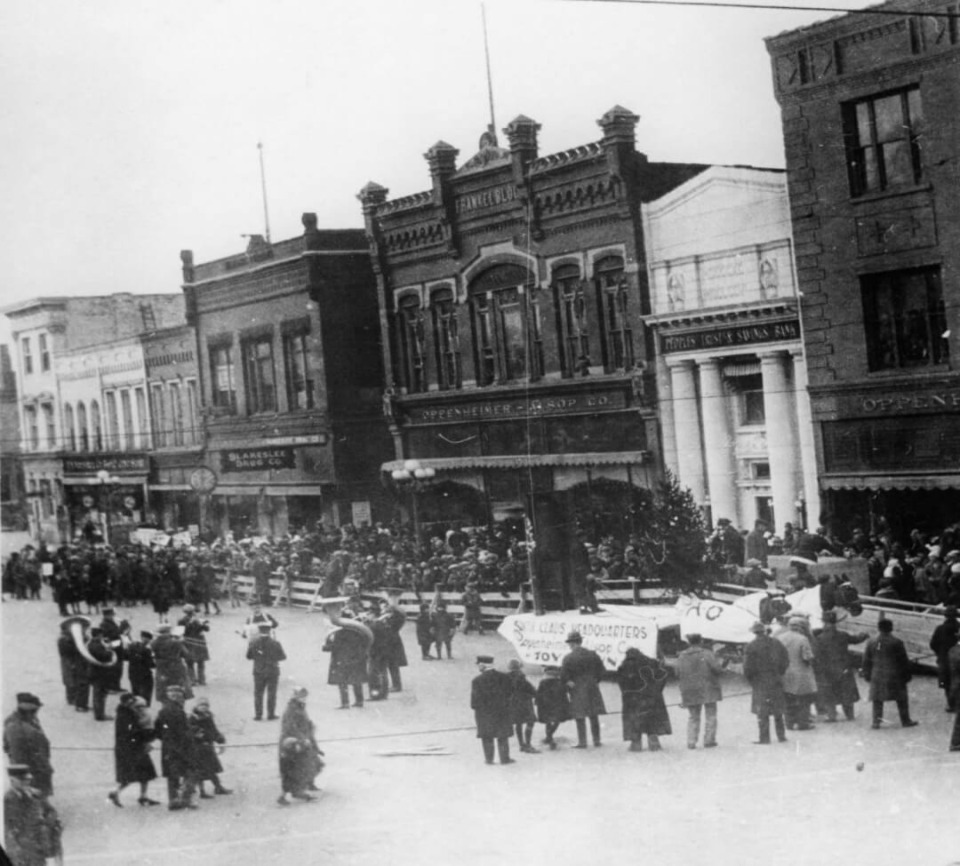
Above: this is a scene during the Christmas shopping season, with the banner stating “Santa Claus Headquarters” and “Oppenheimer-Alsop Co.” underneath it. Note the connection between the two buildings was complete, as each building carried the storefront “Oppenheimer – Alsop Co.”
Then in 1929, the final step was taken as Art Oppenheimer, C.C. Alsop, and Dr. Moses Childress bought out the remaining interest of the Frankels and Baldaufs, and owned 100% of the business. Despite the economic crisis of the 1920s in the agricultural sector following World War I, the Oskaloosa Herald noted the resilience of the 1921 merger, stating “Eight years have seen the Oppenheimer-Alsop company weather an agricultural slump that crushed scores and scores of giant mercantile establishments.” The Herald also noted the sheer impact of this organization—it had over $750,000 in sales, had 60 different departments located in the 60,000 square foot of show and sales space, and over 100 sales personnel. It ended the article in this fashion: “The growth of the Oppenheimer-Alsop company in the face of agricultural depression has been one of the merchandising wonders of the past business decade. During the period of the store’s existence, it has imbedded itself deeply into the community’s affections and confidence, and Oskaloosa and southern Iowa point with pride to ‘the big store.’”
So this merger event officially severed the last tie between the Frankels and Oskaloosa, which had lasted from 1861 with the coming of Isaiah to Mahaska County, to the final sale of the Frankel Oskaloosa business interests in 1929. Ironically, Babette Frankel died on February 28, 1929, the preceding big sale announcement that took place in the Oskaloosa Herald on March 5. It is unlikely that the sale took place solely because of Babette’s death; a transaction of this magnitude takes months to coordinate. The papers reported that she had a lingering illness of more than six months, so it is well possible that she was not even cognizant of the pending transaction. It is quite probable that the transaction was scheduled to close on March 1, which was the same date in 1909 when part of the business was sold to local investors, but was delayed for a few days because of Babette’s death. This gives rise to whether Babette’s preference was to not live long enough to see the final loss of the Frankel connection to Oskaloosa.
The Kresge Years, 1930 to the 1970’s
When C.C. Alsop, Art Oppenheimer, and Moses Childress purchased the Frankel and Baldauf store interests in March of 1929, they likely had something else up their sleeves. In October of 1929, the Oskaloosa Herald trumpeted that the S. S. Kresge Company, more familiarly known as Kresge’s, was coming to town and was to occupy the Frankel Building beginning on March 1, 1930. A later announcement, in July of 1930, confirmed that C.C. Alsop and Art Oppenheimer had been named the managers of the new Central Iowa District of Sears, Roebuck, and Company. This district would encompass the retail locations of Des Moines, Cedar Rapids, Iowa City, and Oskaloosa, and would be headquartered in Oskaloosa in the Baldauf building.
Both Kresge’s and Sears brought the first national retail chains to Oskaloosa. The fact that Oskaloosa was named district headquarters for Sears, when all the other locations were much larger, says something about the retail impact Oskaloosa had at that time. Kresge’s had a rule that it would not go into a community unless it had 20,000 residents within the 1930 census, Oskaloosa had only 10,123 people, which violated the Kresge “rule” not by just a little bit, but by a lot.
Kresge’s had been trying to get its foot in the door in Oskaloosa for three years prior to this, and now that it had a location, it wanted to keep it. It sought an unprecedented 50-year lease with Dr. Moses Childress, the building’s owner. Childress balked at this, and instead negotiated a 30-year lease. Kresge’s did stay in this location for well over that, and was still there in 1972, but under its new corporate name: K-Mart. K-Mart left the location when its new store was built on the east side of Oskaloosa, thus becoming Oskaloosa’s first “big box” store.
Just as Frankel’s evoked fond memories due to its longevity in one location, so did Kresge’s. Along with the department store, a lunch counter was added, giving Kresge’s the honor of having the first enterprise to serve food at this location, a tradition that has continued through the present business, Smokey Row. One of the former employees of Kresge’s offered the following commentary, recapped in the interview below with Ann Brouwer:
The following memories come from JoAnn Van Ommen Slagter, 89, of Oskaloosa, who shared about her experiences while working at SS Kresge in the Frankel building beginning in 1948. The store existed in Oskaloosa from 1924-1954. The building, now housing Smokey Row, later became a K-Mart upon SS Kresge’s leaving. Oskaloosan Virginia Walker, owner of the McNeil Stone Mansion, is a cousin of the Kresges.
During Slagter’s time at SS Kresge, the store contained nine counters displaying bulk candy, jewelry, cosmetics, greeting cards, and toys, along with many other items. A large lunch counter spanned much of the south wall, and an ice cream counter sat in between the building’s two entrances at that time. An individual employee tended to each counter, maintaining and organizing the inventory and keeping charge of the cash register. Whenever a customer gave them more than a $5 bill, which rarely happened, they had to call a “floor walker” to retrieve it. As a counter employee, Slagter made $15 per week. She noted that during her time at SS Kresge, people would come to Oskaloosa for the day from all of the surrounding towns to go out to eat and shop!
At that time, Sears and Roebuck occupied the corner building to the north (now Brown’s Shoe Fit Co.), and the upper floor of the Frankel building could be accessed from the Sears store and was used as its furniture display area. Though this access area is now bricked over, the remnants of it are still visible from the upper floor. The basement of the Frankel building connected to Sears’ basement, as well. A stairway in the alley on the south side of the Frankel building (now The Alley project) provided additional outside access to this basement space.
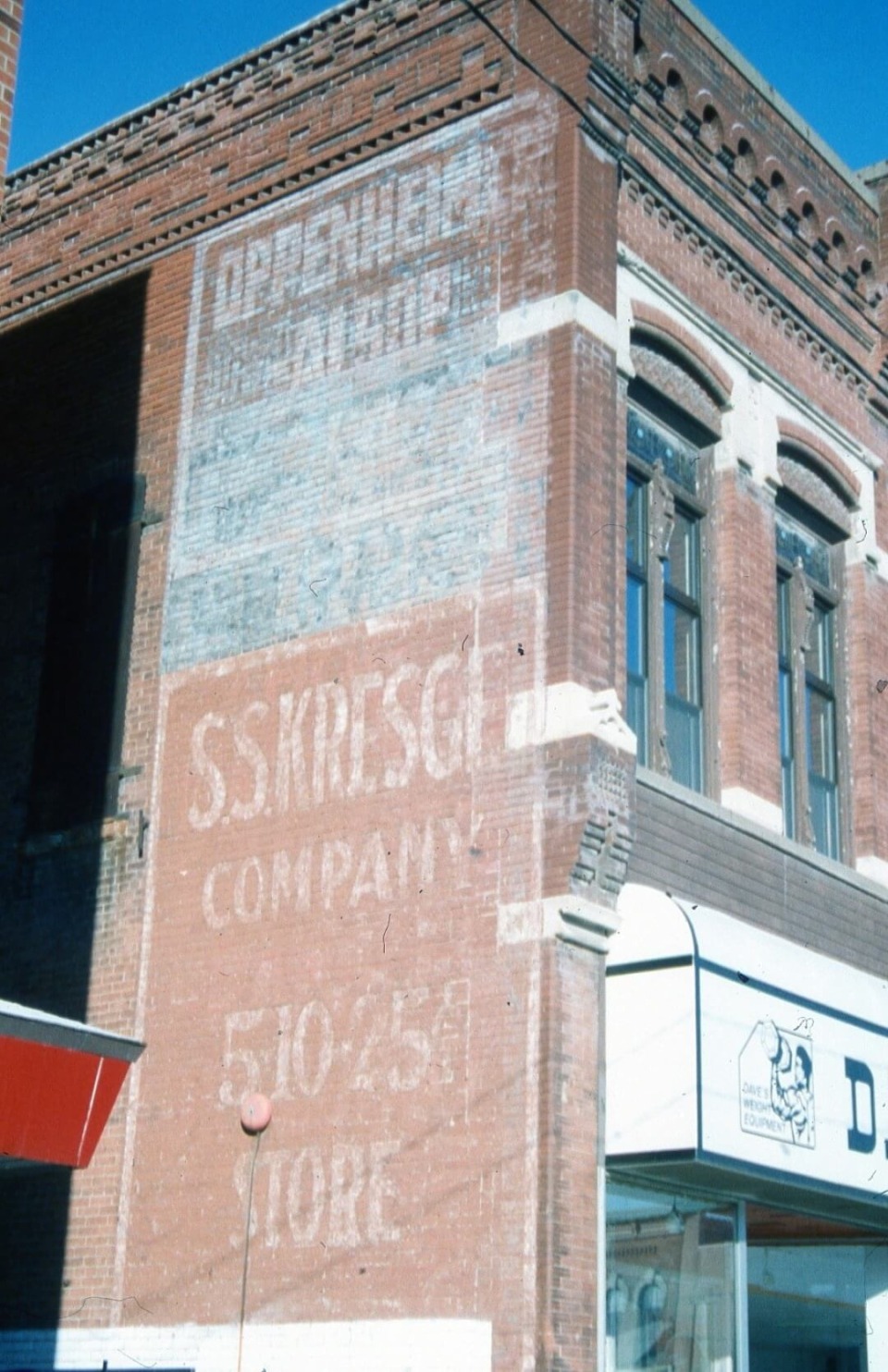
Right: Two “ghosts” of Oskaloosa’s retail past, still visible on the southeast side of the Frankel Building. The first represents the Oppenheimer-Alsop enterprise, which was from 1921 to 1930. The second is the S. S. Kresge Company, with its familiar notation of being a 5-10-25-cent store, with stores like this often generically referred to as “five and dime” stores. Kresge’s was the forerunner of K-Mart, and leased this location from 1930 through the mid-1970’s
It was during this time of the Kresge/K-Mart presence that one of the most unusual names appeared in the chain of title of the building. Prior to the Frankel ownership, the property had been bought and sold many times in those heady pioneer days with people quick to move on in the hope of better fortunes, typically out west but also elsewhere. There may have even been a sense of recklessness, as judgments attached to the properties resulted in two foreclosures via sheriff’s sales during that pioneer era. The abstract shows 43 different names of owners in those early days, with old-fashioned names like Parish, Mehetabel, Mahala, and Ziepha appearing in the record. However, it wasn’t until these later years that a very strange name appeared.
Remember that Dr. Moses Childress owned all of the building and part of the retail business before the building was leased to Kresge’s. Dr. Childress died in 1952, and the Frankel Building went to his children, with a son dying soon afterwards, in 1956. The probate record below shows that the doctor had named this son in recognition of his profession:

The Years of Lost Identity, mid-1970s to 1996
Once K-Mart moved out of the building, the structure became the home for businesses that remained for short periods of time and then left, with the building owners purchasing it only for rental income, and never to invest in it or use it for themselves. Over time, the building was home to 3 clothing stores, a TV store, a video store, and a CPA firm. This was during the agricultural crisis of the late 1970s and 1980s, in which rural communities suffered a huge loss of population, businesses, and farm-related spending. The pictures below show the various enterprises, with the “Going out of Business Sale” banner a sign of those turbulent times.
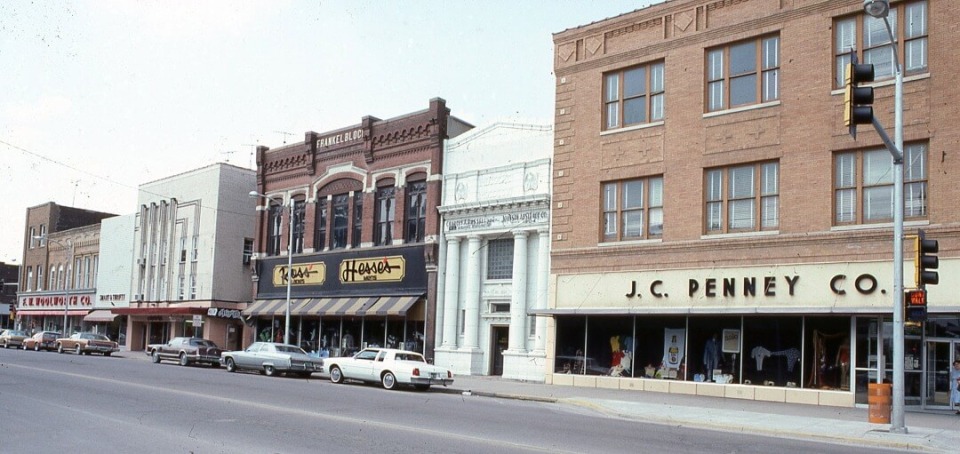
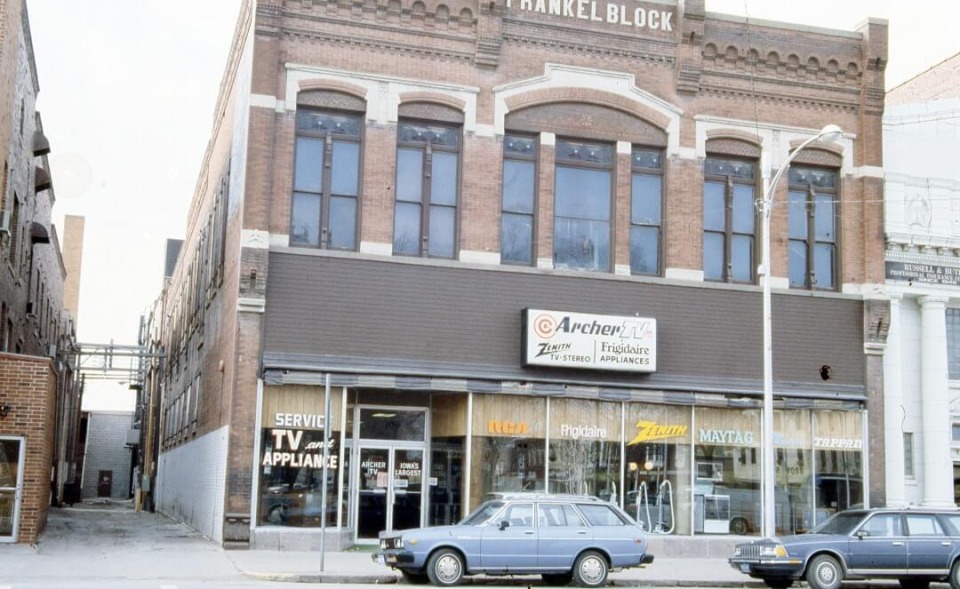
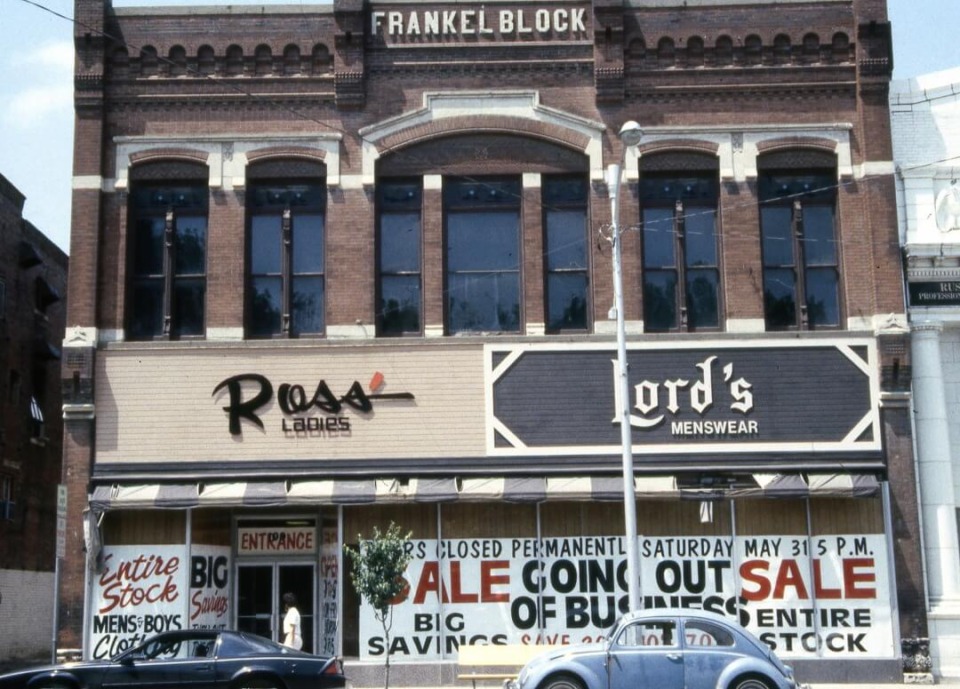
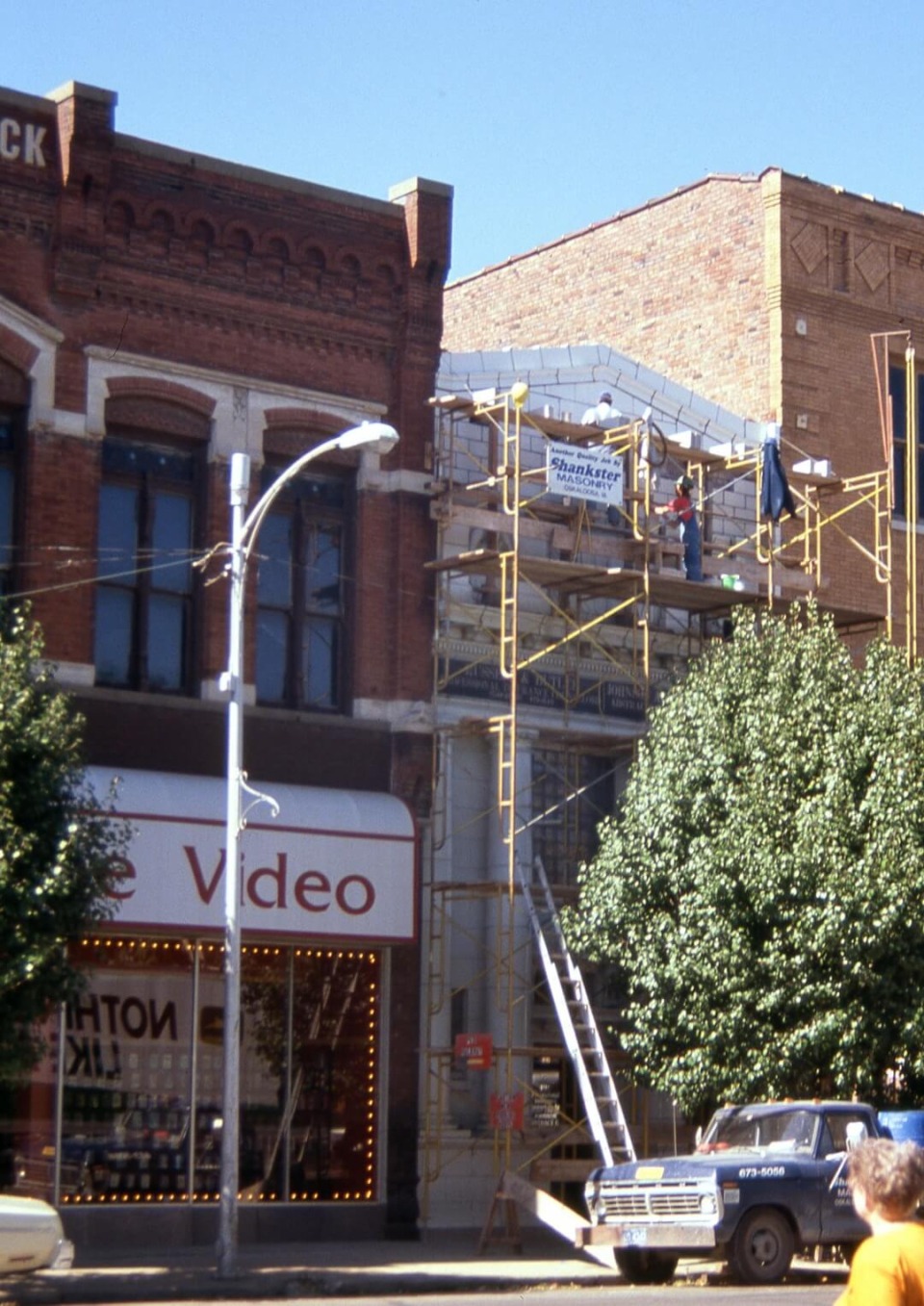
It was during this time when the investment company that owned the property, Town and Country Estates, Inc., could not meet its financing obligations. Foreclosure proceedings began by a Centerville bank in 1994, and after the requisite sheriff’s sale when no other parties came forward to bid on the property, the bank became the owner of the Frankel Building in satisfaction of its judgement.
The bank’s sale of the property to Iowa Rural Housing, Inc. gave the property its most notorious owner. Iowa Rural Housing Inc. was a company owned by Scott Hinkley, Sr. He had come to Oskaloosa to work in the development office for William Penn College, and, in fact, was an ordained Quaker minister which fit in well with the college’s theological roots. He eventually left the college and began buying and selling rural properties in Iowa and Missouri. As he needed capital for this venture, he sought out investors and promised and delivered high returns, which in turn attracted more investors. His success was obvious in Oskaloosa, as he had a beautiful home with an in-ground swimming pool by Edmundson Park, he had an attractive business building a couple of blocks from the square, and he drove around town in a Lamborghini worth $200,000. However, it was all a charade—the business was not making money at all, with Hinkley siphoning off the dollars from new investors to give payments to the old investors, as well as to support his lavish lifestyle. It was the classic Ponzi scheme, and Hinkley was about to get caught as there was insufficient money to pay the investors their promised returns. He left Oskaloosa under the guise of a business trip in June of 2000, went to Florida, and then left for the Dutch island of St. Maarten in the Caribbean on his luxury yacht valued at $1.3 million. With him was a stash of diamonds, cash, a rifle, and nautical maps from all over the globe. Later that year he was arrested on his yacht in St. Maarten, and was found guilty of mail fraud and money laundering, having bilked investors out of more than $5 million in the sham housing business. After being released from jail in 2004, he missed an appointment with his probation officer, and became a fugitive by fleeing to Mexico. He remained there almost 2 years before walking across the border into Laredo, Texas, and turning himself in.
Right: news headline showing Hinkley’s return to Iowa after turning himself following his escape to Mexico. Virtually all news stories at the time described him as “Scott Hinkley, the former Quaker minister” in an effort to show the mis-match of his deeds with his vocation.
The Crisis Years, 1996 through 2002
In 1996, David Rempe purchased the building for $50,000. He owned and operated a fitness center known as Dave’s Weight Club, and occupied all three levels of the building with various exercise, fitness, and weight-lifting equipment. There was much enthusiasm in the Oskaloosa community as there was finally a business on the square being operated by the person that owned the building, offering a service that would bring folks downtown. However, the euphoria was short-lived—in what would be a fatal mistake to the building—as Rempe cut off a key support pillar to make room for recreational equipment. On April 21, 2002, a portion of the roof collapsed due to the loss of the pillar, and on May 3 more of the roof and part of the north wall collapsed due to heavy rains. Unfortunately, the owner’s insurance did not cover the cost of demolition or rebuilding. As a result, he went to the Oskaloosa City Council explaining that he did not have sufficient resources to continue owing the property, and told them he was going to walk away from the building and not pay any more property taxes. However, much to the advantage to the city, he said he would work with them to deed the building to them if they could find a solution, rather than wait for the three-year process of a delinquent tax sale to take place, after which the problem would revert to the city anyway.
With this opportunity also came responsibility and risk, as well as differing opinions. The north wall was of special concern, as it held up a beam that supported the roof structures on the two buildings to the north of it. Additionally, the north wall was a “party wall” with the south wall of the building next to it. Finally, the time frame was short—the weakened building was not expected to survive the winter, according to structural engineering experts.
After investigating the costs of demolition versus rehabilitation, which took some time, the City Council began discussions in earnest in September of 2002 with a number of special meetings and with strong opinons each way. Some thought retail in Oskaloosa was “a dead horse”, so therefore believed there should be no investment in the property. Keeping up the animal theme, others called the building a “white elephant” that no one would want to buy even if it was fixed up. Others noted the vast sums of money the city planned to spend to improve the roads and traffic signals for the new Super Wal-Mart on the west side of town, and wondered why just a fraction of that amount shouldn’t be spent in the downtown area. Adding to the mix was the owner of building to the north, who reminded the city of the party wall agreement, and who threatened to sue the ity if that wall was removed or altered in such a way that their building’s integrity was compromised. Others pointed out that a post-demolition empty lot does not send a good message about the vibrancy of the community, and an empty building is probably better.
Finally, an agreement was hammered out, which surprisingly received the support of all of the Council members. Since the cost of rebuilding the structure to have a safe shell of a building was estimated to be $190,000, while the cost of demolishing the building was estimated to be $130,000, here was the compromise: the city would donate $110,000 towards saving the building and placing it in the hands of a private owner if the community would contribute the remaining $80,000. The Council meeting was on October 21 and the deadline for fundraising was October 31.
By Jennifer Swanson
The Oskaloosa HeraldAfter waiting two weeks and two special City Council metings on the old Frankel Building downtown, the council decided Monday night - to wait another week.
Some councilors were ready to tear down the building last night. But proponents of saving the building swung the council around to waiting while they finalized their cost estimates. The council will make a final decision at its regular meeting 6:30 PM Monday, Oct. 21.
Councilor Mike Stout said he was "disappointed" that those who want to save the Frankel Building want yet another week.
"I don't think another week's going to change my mind," he said. "I personally feel that this is more a safety issue than a historical issue."
Headline and excerpt from newspaper article during those times when the fate of the Frankel Building rested in the hands of the City Council, with demolition of the building a very real possibility.
Fortunately, groups interested in the preservation of the Frankel Building were already at work. Main Street Oskaloosa, the group of businesses in the designated Main Street district, along with the Oskaloosa Chamber, had spearheaded a collection effort prior to the meeting and had received $40,000 in donations. The vision gained momentum: a Main Street Board Member and business owner noted, “I have little old ladies calling me and asking, ‘How do I help pledge to save the Frankel Building?’” Descendants of the Frankel family were found and many contributed to the cause. Not everyone, however, jumped on the bandwagon, most notable the Mahaska County Supervisors. The chairman of the Oskaloosa Historic Preservation Committee and the Main Street director made a plea to the Mahaska County Supervisors for a contribution. A motion to donate $10,000 towards the cause died for a lack of a second. Following the meeting, one of the county superviors told a newspaper that he was skeptical over claims that the building would be a good development area, citing numerous empty buildings that already plague the city.
Despite the refusal of the Mahaska County Supervisors to participate, the needed funds were raised. This included a $30,000 contribution from Cincinnati Insurance, the company that insured the building to the north of the Frankel Building, which was subject to the party wall agreement. The insurance company obviously looked at the cost of shoring up the wall and/or litigation, and decided that a significant donation was the better choice. The City Council met on November 4, confirmed the fund-raising donations from Main Street and the Chamber, and officially approved the $110,000 contribution to the effort. As winter was looming, the process started quickly. The very next day, on November 5, Dave Rempe signed a deed for the building, transferring it to Oskaloosa Downtown Development, LLC. This group was a civic-minded organization interested in improving Oskaloosa’s downtown, and took it upon themselves to hold the ownership of the building while the major rehabilitation project took place. This was no small endeavor, and the group would bear the risk for any liability or cost overruns that took place during the project. Contracts were quickly signed with Merit Construction, which capped the rehabilitation and repair costs at $190,000.
The Final Result, 2003 to Present
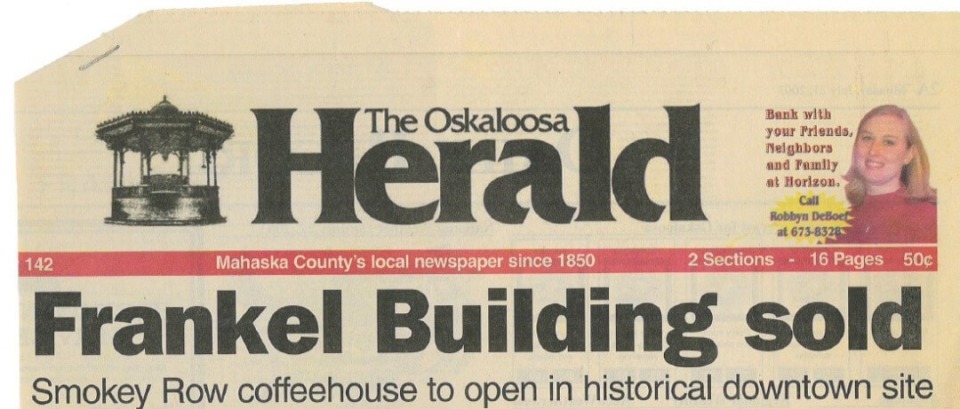

The above headline, dated July 21, 2003, trumpeted the successful culmination of the rescue of the Frankel building. Krista Bennett, who owned and operated successful coffee shops named “Smokey Row” in Pleasantville and Pella, purchased the building and opened up a coffee shop and gathering space, much to the delight of the City leaders and the downtown business community.
Since that time, the Frankel Building as occupied by Smokey Row has become one of Oskaloosa’s main gathering spots. This isn’t just for the coffee and the meals, but also for meetings, the dissemination of information, and the exchange of ideas. One of the more popular occurrences are the Oskaloosa Chamber’s “Eggs and Issues” events, which are held on periodic Saturday mornings. Speakers address various topics, with the audience able to ask questions as they see fit.
Additionally, given the importance of Iowa first-in-the-nation cacuses during the presidential elections, the Frankel Building has become a stopping point for political figures all across the political spectrum, as evidenced by the pictures below.

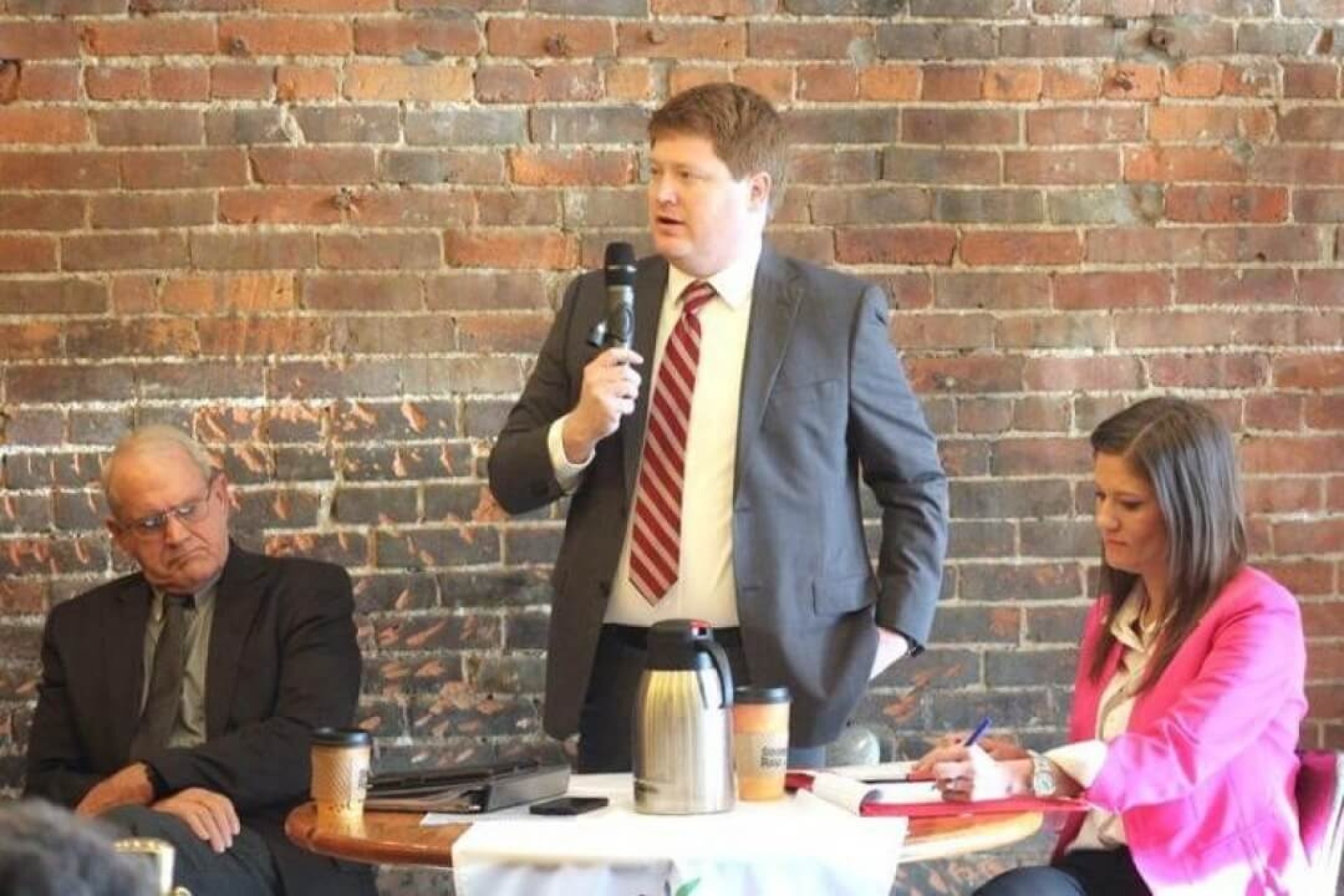
National and State Figures: (Left) Barack Obama, then-presidential candidate, and later President, stumping in front of the Smokey Row menu board. (Right) Iowa Legislators from Mahaska County—Ken Rozenboom, Dustin Hite, and Hollie Vanden Heuvel Brink—discussing issues from the State Capitol.
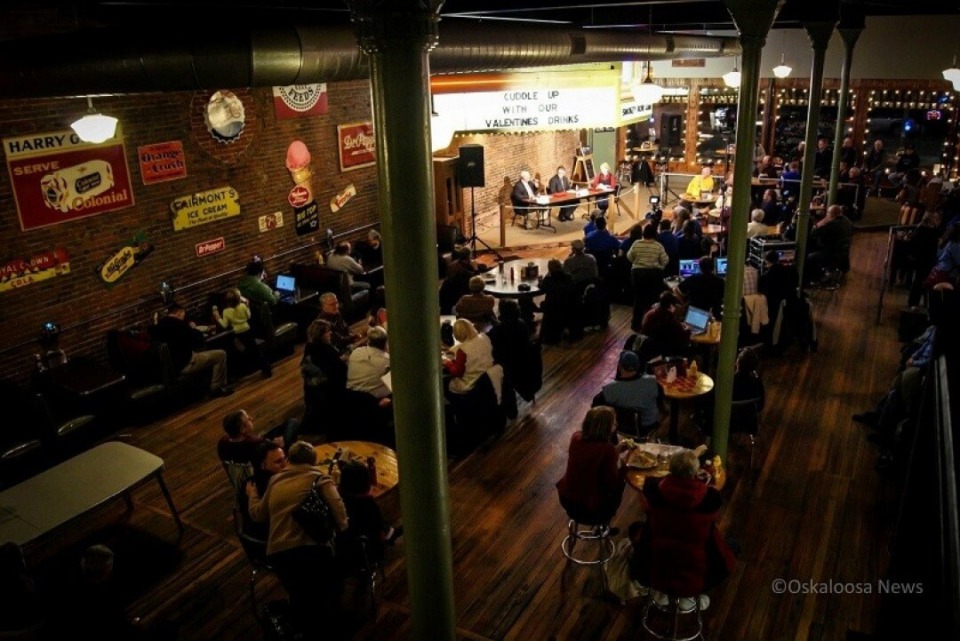
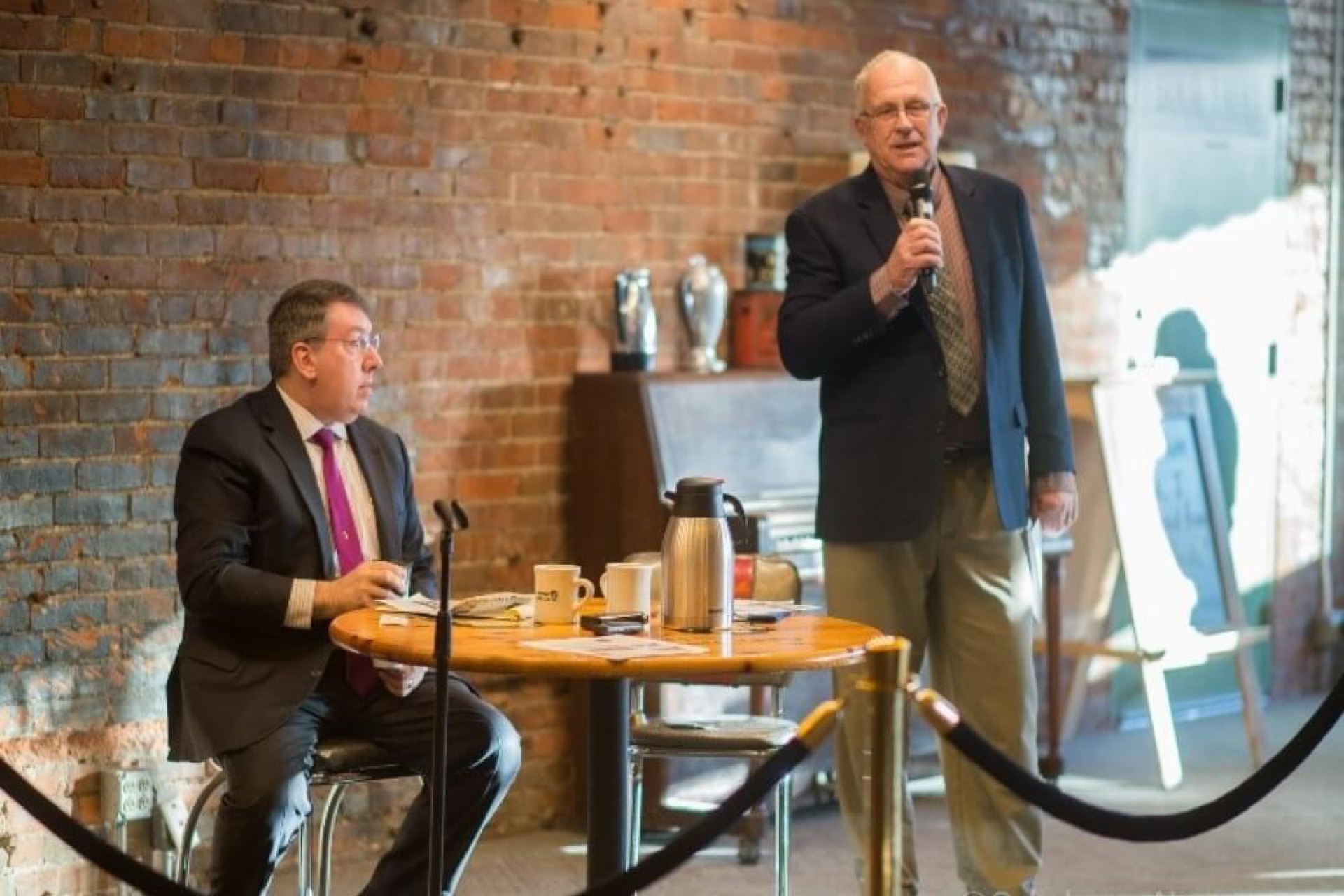
County and City Figures: (Left) An evening debate with Mahaska County Supervisor candidates Mark Doland and Tom Reilly. (Right) Oskaloosa Mayor Dave Krutzfeld and then County Supervisor Willie VanWeelden field questions at Eggs and Issues.
Video
Frankel Building Marker Video Presentation
Sources
- Ames Daily Tribune and Evening Times, Babette Frankel Death 28 February 1929
- Bell, Michael J., “‘True Israelites of America’: the Story of Jews in Iowa,” The Annals of Iowa, Volume 53, Number 2 (Spring 1994) (General information on Jewish Settlement in Iowa)
- Daily Iowan, “Sears Roebuck in Oskaloosa,” Iowa City, 17 July 1930
- Des Moines Daily Leader, “Strasburger & Pfiefer Dissolution” 6 February 1902
- Des Moines: The Pioneer of Municipal Progress and Reform of the Middle West, Together with the History of Polk County, Volume 2 Chicago, S.J. Clarke Publishing Company, 1911 (Leopold Sheuerman Profile and Picture)
- Federal Censuses—1860, 1870, 1880, 1900, 1910, 1920
(Macon County, Missouri; Polk County, Iowa; Mahaska County, Iowa) - Fields, Fred & Barbara family website (Frankel and Sheuerman) www.frf.com
- Fleishaker, Oscar, The Illinois-Iowa Jewish Community on the Banks of the Mississippi River, June 1957, Doctor’s degree dissertation for Yeshiva University (general information plus specific information on Sheuermans who started in Muscatine/Davenport)
- Glazer, Rabbi Simon, The Jews of Iowa, Koch Brothers Printing Company, Des Moines, 1904, pages 228-231: Frankel/Sheuerman marriage story; page 207: Oskaloosa and Marengo Jewish owned businesses
- Hedge, Manoah, Past and Present Mahaska County, The S.J. Clarke Publishing Company, 1906
- Theodore Kent (T.K.) Smith biography
- 1850’s trip around the square, Chapter 33
- Ichenhausen, Germany synagogue membership list 1843 http://www.angelfire.com/ab7/yamey/SYN.html
- Iowa State Censuses—1885, 1895, 1905, 1915, 1925
(Mahaska County and Polk County) - Isaiah Frankel Mausoleum (and other gravesites) www.findagrave.com
- Jacobs, John (Personal collection)
- Trade Card of I Frankel & Co.
- Invoice of Strasburger & Pfeifer
- Lucas Countyan, Rabbi Handler Story, May 12, 2018 http://lucascountyan.blogspot.com
- Macon County Historical Society, Macon County (Missouri) in the Civil War www.maconcountyhistoricalsociety.com
- Mahaska County Auditor’s Office--Auditor’s Transfer Books for Lot 2, Block 20 of the Original Plat of Oskaloosa, Iowa (Transfer records of Frankel Building)
- Mahaska County Clerk of Court, Probate Record N, Page 569, Will Record C, Page 180 (Probate record and will of Isaiah Frankel)
- Mahaska County Recorder’s Office, Deeds: Book 2, Page 447; Book 40 Page 397; Book 40, Page 376; Book 40, Page 396; Book 62, Page 547; Book 94, Page 470; Mortgage: Book 23, Page 640 (Note: Deeds and mortgage for Frankel Building involving the Frankels. All other deeds and mortgages involving ownership pre and post-Frankel ownership can be searched at the Recorder’s Office, or can be found by looking at the original abstract in possession by owner of the building.)
- Marquis, A.N., The Book of Chicagoans, A Biographical Dictionary of Leading Men Living in the City of Chicago Volume #2, 1911 (Emanuel Bach Biography)
- Men’s Wear (semi-monthly trade journal), “Pfeifer-Belmont Company dissolved; changed to Pfeifer Dry Goods Company,” Volume 22, Page 102, 1906
- Oskaloosa City Square Commercial Historic District nomination form for the National Register of Historic Places—website: https://npgallery.nps.gov/pdfhost/docs/nrhp/text/86000716.PDF
- Ottumwa Courier, “Mahaska County Supervisors Refuse Funding” November 5, 2002
- Oskaloosa Daily or Weekly Herald-on Microfilm at the Oskaloosa Public Library (Various issues of interest below)
- Frankel Business Interests prior to Frankel Building: May 6, 1869; July 10, 1869; November 30, 1876; April 5, 1877; May 3, 1877; May 10, 1877; March 20, 1884; June 28, 1887; February 16, 1888
- Frankel Building Construction, Opening and Advertising: February 7, 1889; March 28, 1889; July 11, 1889; August 8, 1889: August 15, 1889; November 7, 1889; December 12, 1889
- Isaiah Frankel Death: April 2, 1897; April 3, 1897; April 5, 1897
- Frankel Store Articles: November 25, 1909; January 4, 1921; March 5, 1929
- Kresge Articles: October 15, 1929; October 23, 1929
- C. C. Alsop History: December 24, 1914; July 3, 1950
- Frankel Building Collapse, Restoration and Sale: April 22, 2002; August 6, 2002; September 17, 2002; October 1, 2002; October 15, 2002; October 28, 2002; October 29, 2002; November 26, 2002; July 21, 2003
- Oskaloosa Globe -on Microfilm at the Oskaloosa Public Library
- Frankel Store Articles: October 27, 1909; September 13, 1913
- Phillips, Semira, Proud Mahaska, Herald Printing, Oskaloosa, 1900--Frankel story beginning on page 351
- Portrait and Bigraphical Album of Mahaska County, Iowa, Chapman Publishing Company, Chicago 1887, pages 423/424: Isaiah Frankel biography
- Russell, Charles (Chuck)—private email 9 June 2010 to Jan Olive (Nash) Full of Tallgrass Historians, L. C. (description of Jewish influence in Oskaloosa)
- Sioux City Journal, “Scott Hinkley Return to Iowa” 13 July 2006 https://siouxcityjournal.com
- The Des Moines Register:
- Leopold Sheuerman Death: 21 January 1917
- Frankel named President of Younkers: 15 September 1937
- Joseph Rosenfield Death: 8 June 2000
- Scott Hinkley Investigation: 3, 4, 5, and 6 December 2000
- The Dispatch; The Rock Island Argus, “Scott Hinkley Sentencing” 17 February 2001; 23 September 2001 https://qconline.com
- The Greater Des Moines Jewish Press May/June 2014 (Story of Sheuerman Family)
- The History of Iowa County, Iowa, Union Historical Company, Birdsall, Williams, & Company, 1881 (Leopold and Abraham Sheuerman Histories)
- The Oskaloosa Times Souvenir of Oskaloosa, Mahaska County, Iowa, published in 1896 by Times Co. in Oskaloosa (pictures of Isaiah Frankel and Frankel Building)
- Tinker v. Des Moines Independent School District www.wikipedia.org
- University of Iowa Digital Library, Louise Noun Scrapbook:
- A Bit of Family History as told by Babette Sheuerman Frankel
- -The Binau Blatt
- William Penn University, Wilcox Library Digital Archives, Oskaloosa, Iowa (pictures of Frankel buildings on north and east side of the Square) http://cdm270701.cdmhost.com/cdm/
- https://mb.nawcc.org/threads/t-k-smith-oskaloosa-ia-pocket-watch.153510/ (Image of the T.K. Smith pocket watch)
Tennant History
1899
I. Frankel & Sons (Clothing)
Drs. W.H. Reilly and M.J. Tenny (Basement)
1902
Frankel Dry Goods (Clothing, Occupied 107 S Market)
Pfeifer Belmont Co. (Dry Goods, Occupied 109-111 S Market)
1911
Frankel Dry Goods Co. (Henry Frankel of Des Moines, Pres.)
1925
S.S. Kresge (Occupied 107-111 S Market)
1936
Central Shoe Store (Occupied 107 S Market)
S.S. Kresge Co. (Occupied 109 S Market)
1954
S.S. Kresge Department Store
1985
Lord's Menswear (Occupied 107 S Market)
Ross' Ladies Clothing (Occupied 109 S Market)
2017
Smokey Row Coffee House


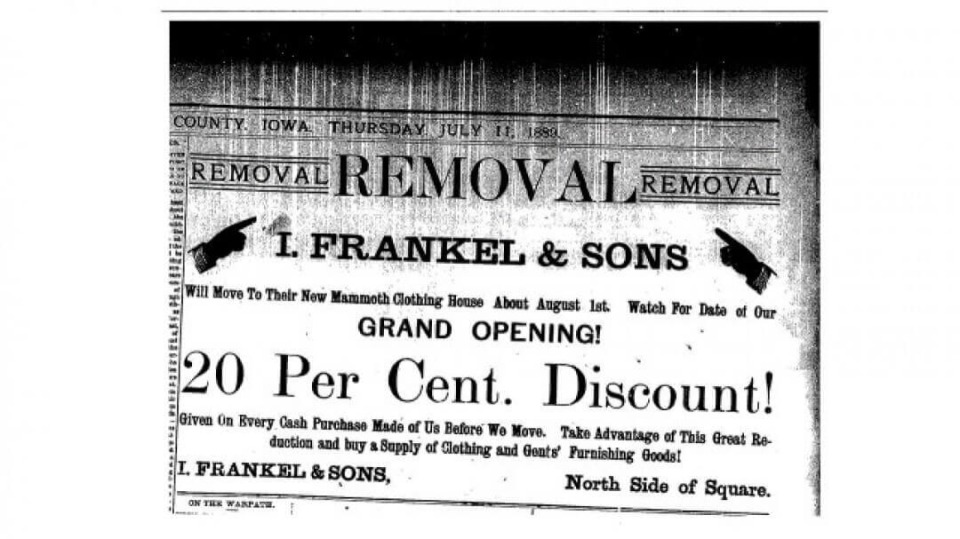
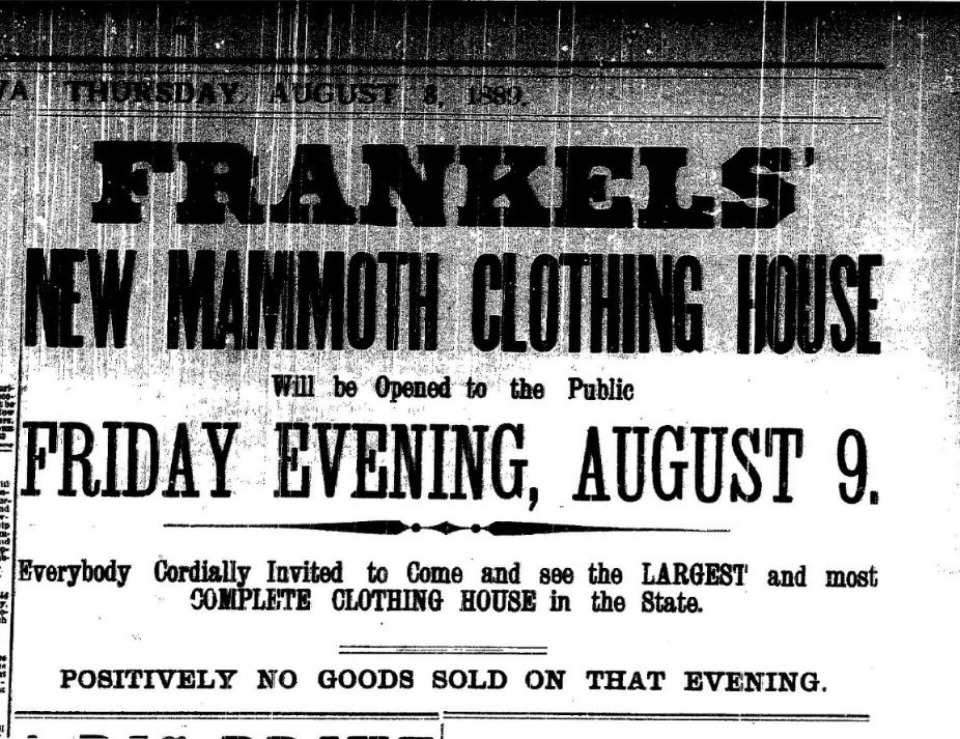
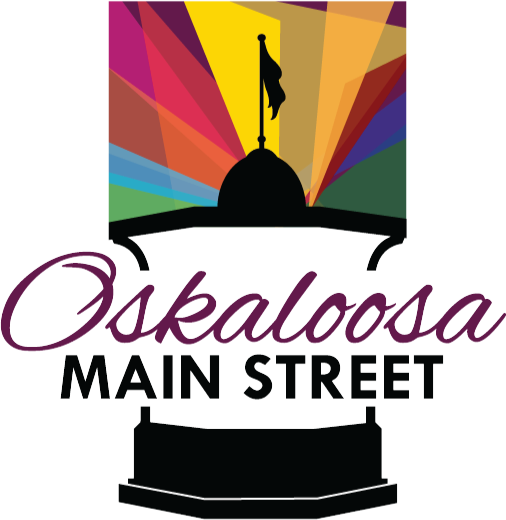


Find us on Facebook!